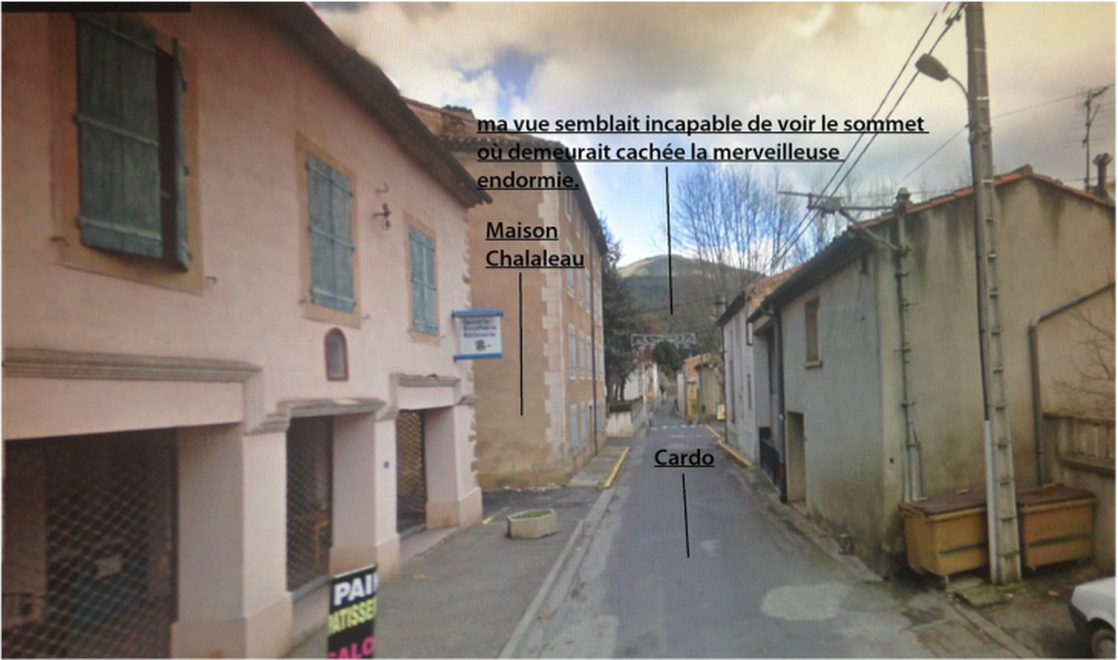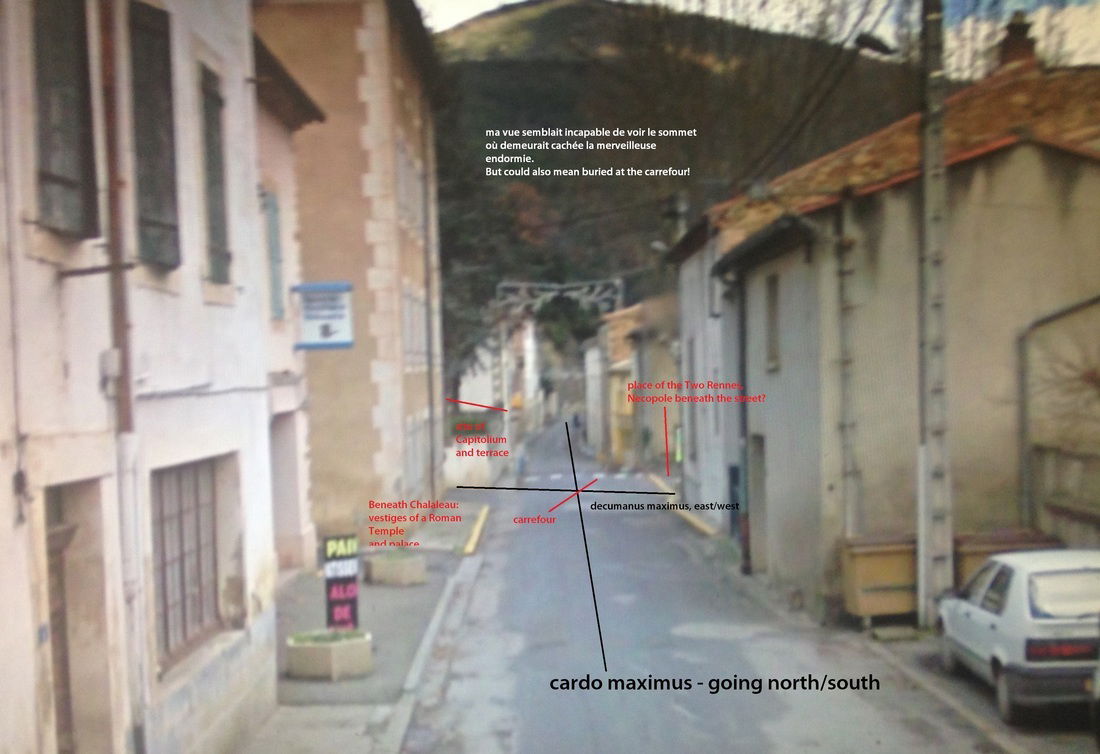A Literary or Literal White Queen of Rennes-les-Bains?
In a document called THE COUNTRY OF THE WHITE QUEEN a curious connection is made between an imagined white queen of Rennes-les-Bains [in the form of a statue] and a real historical 'white queen', Blanche d'Evraux. Playing on the sound and spelling of the French and English words for white [blanche] and queen [reine/Rennes] the author makes a comparison about a tale of an underground Temple at Gisors associated with Blanche d'Evraux with a similar tale of an underground Temple at Rennes-les-Bains associated with a 'white statue'. To understand why these comparisons are made we have to appreciate how & why the language was used and only then can we see how it is related to the wider enigma associated with Rennes-les-Bains.
'Au Pays de la Reine Blanche' [The Country of the White Queen] was a text written by Nicolas BEAUCEAN. Beaucean is the probable nom-de-plume of Philippe de Chérisey, or perhaps Pierre Plantard, two main steering characters behind a group created in the 50's by Plantard called the Prieuré de Sion.
Many Prieuré texts published anonymously use literary tricks and sleights of hand to refer the alert reader to a 'mystery' at Rennes-les-Bains and Au Pays de la Reine Blanche is one such text.
Gerard de Sède, a colleague of Plantard for a few years before having a public fall out over money, discussed this policy of literary trickery saying Plantard often created mystifications to conceal something. The linguistic gymnastics employed were so Plantard could speak of a 'mystery' in a guarded way. De Sède wrote;
' ... the maker of a stupendous discovery, would, if he were unable to reveal it, be the prisoner of an almost intolerable contradiction, between his pride that would ..... impel him to make it public, and his fear, which would constrain him to remain silent....'
It has echoes of a sentence Chérisey wrote in a private letter around 1965;
'... What do you believe ..... I will seek in Rennes-le-Château? If I succeed I will not have the right to speak about it'.
As de Sède correctly observed in his book 'The Accursed Treasure of Rennes-le-Château' … for his two informants, the Affair of the Two Rennes seemed to be of great import …. and thus these tricks were not just for deliberate obfuscation but to disseminate [or perhaps obtain] information.
LITERARY TRICKS
The Prieuré publishers/authors wrote in an ambiguous language to promote and shield knowledge. They certainly used what we would call circumlocution - which means literally to talk around a subject, using words or expressions that are difficult for others, or more precisely perhaps, outsiders, to understand. It is a kind of jargon, a word that harks back to Anglo-French by way of Middle English and means the "twittering of birds". Chaucer, the great English poet and “first finder of ... language” referred to jargon as 'the utterance of birds or sounds resembling birds'. Using this jargon as the 'twittering of birds' is our first hint that the sound of words might be just as important as how one reads them. It is an esoteric language intended to be understood by a small number of people with specialised knowledge or those interested with ears to hear.
Plantard and Chérisey and others in the Rennes Affair [particularly Henri Boudet] utilised this bird-speak to great effect. To understand one has to hear the sound of the word rather than read the word. It is a question of no longer trusting "the written" but of hearing the sound. In this language "double meaning" prevails, enabled by homophony (and other mechanisms). It is the sound, in short, that "resonates". Often also called the "Language of the Birds" it is a metaphoric way of describing a way of reading a text in which language moves forward by means of puns and wordplay rather than being guided by a narrative.
The "language of the birds" is a concept that appears in various mythologies, mystical traditions, and folklore, often representing a secret or divine language that grants knowledge or understanding. In European alchemy and esoteric traditions, the "language of the birds" is believed to be a symbolic or hidden language, connected with the transmission of occult or mystical knowledge. For example Alchemists described their writings as encoded or encrypted in a way only those with special knowledge could interpret. The concept is also found in the Bible, for example, King Solomon is said to understand the language of animals, including birds, which symbolised his great wisdom. Similarly, in Greek mythology, the hero Tiresias was granted the ability to understand birds after a divine transformation. And in various folktales, the ability to understand the language of birds is often a gift given to certain heroes or chosen individuals, typically representing access to hidden truths. Birds in these stories act as messengers between humans and gods.
One has to enter in to this kind of fantasy world of language, poetry, imagination etc to start to understand the Priory of Sion. Of course, not many have the Poets intuition or intellect, which is why so many miss the point or reduce everything to superficiality saying 'it is all a hoax!" They are even less likely to 'see' and 'hear' the words.
Hearing and Seeing
'Hearing' and 'seeing' words rather than 'reading' them is as old as the Egyptian hieroglyphics. The Egyptians called their hieroglyphs “the words of God” and were used mainly by the priests. Unlike the simple elegance of modern writing systems, this early attempt at recording words used a number of techniques to convey meaning. The picture symbols represent a combination of alphabet and syllabic sounds together with images that determine or clarify the meaning and depictions of actual objects which are the spoken word of the thing they represent. Much later in history when the analogy with birds was made it is because sounds were thought to literally fly from the letters of the words which remain fixed. The popular proverb "The writings remain the words fly" also testifies to this symbolism.
Jean-Claude Flornoy speculated that the expression 'language of the birds' may even be an historical phonetic distortion of the name of a secret and old brotherhood called the "language of the goslings " (in reference to the young goose, a term that has become archaic), "so named because of the crow's feet worn by the builders of the Medieval cathedrals. These medieval Cathedral builders used on their construction sites a jargon allowing them to preserve the ancestral techniques of the "masons". However, after the “Strike of the Cathedrals” (following the proclamation of the Templars as non grata in France the March 19, 1314), most of these initiated builders and workers fled the French Inquisition, for northern Italy (where they would prepare for the Renaissance) and the Middle East".
He continues;
"After this Inquisition, the initiates, back in France, disseminated their knowledge by means of secret coding systems quickly assimilated in to the occult sciences: for example, the Tarot de Marseille, the "goth art" (art of light, which will become Gothic art), alchemy and of course, the language of birds. The language can even be dated much earlier as it seems to have some relationship with Provençal poetry, from a time when the Medieval troubadours composed "cants" that were called "open" when they meant what they said and "closed" when they said one thing but meant something else. So in their poems words could seem to be almost magically linked by means of their aural or visual similarity. Once two words have been glued by this formal correspondence, we take the connection to be a form of "truth". As some have identified, we could consider the Language of the Birds as an imaginary folklore that links a whole lineage of poets, from the Provençal troubadours to Clement Marot, Rabelais, Gerard de Nerval, Alfred Jarry, Raymond Roussel, some of the surrealists like André Bretón, Michael Leiris and the elusive Marcel Duchamp. Most recently that lineage continued through the OuLiPo group'.
This last group is one to which Chérisey was a member - the so-called French ’pataphysicians'.
The 'historical' White Queen of Chérisey and Plantard
In 'The Country of the White Queen' the historical white queen is Blanche D'EVREUX who retired to the Tower of Neaufles at Gisors in 1359. Her ancestry was very illustrious being traced back to Ida of Lorraine who was the mother of the famous Godfrey de Bouillon. Ida was daughter of Godfrey III, Duke of Lower Lorraine and his wife Doda. Ida married Eustace II, Count of Boulogne and they were parents of not only Godfrey de Bouillon but also;
- Baldwin I, King of Jerusalem &
- Eustace III Count of Boulogne, patron of the first Knights Templar.
Her family is linked with the later Anjou dynasty, a dynasty said to possess inner knowledge about the fate of the biblical Mary Magdalene. This dynasty may also have been the root behind various legends associated with the Magdalene which they later encoded in their family history via the Tarot cards and other vehicles. [See HERE].
The origin of the particular Tarot Marseille deck of cards used by Plantard and Chérisey came from groups close to this Anjou dynasty and others such as Ficino. Plantard and Chérisey of course suggest that a sacred tomb, hinted at as being that of Mary Magdalene, is linked to a mythical white Queen in the vicinity of Rennes-les-Bains. In the poem Le serpent Rouge the authors wrote;
"From her that I wanted to free, rose towards me the emanations of perfume which permeate the sepulchre. Once some called her: ISIS, queen of the beneficent springs, COME TO ME ALL YOU WHO SUFFER AND WHO ARE OVERWHELMED AND I WILL COMFORT YOU, otherwise: MADELEINE, with the famous vase full of healing balm. The initiates know the true name: NOTRE DAME DES CROSS".
These themes tie up to suggest that there might be some kind of occult knowledge, in the true sense of the word - those who possess "knowledge" belonging to an inner circle about a significant as yet undefined historical burial in the area of Rennes-les-Bains.
Plantard's TAROT
We know that Plantard painted twenty-two paintings corresponding to the twenty-two cards of the Marseille tarot deck - and in these painting backgrounds there appears landscapes and buildings linked mainly to Rennes-les-Bains. Unfortunately, only five of these paintings are available in the publication "Le Cercle" presented by his son Thomas in 1992. Plantard used the OSWALD WIRTH TAROT deck of 1889 to base his own paintings on. This was the deck that French occultists also associated with the Hebrew alphabet and the cabalistic Tree of Life.
Below - the OSWALD WIRTH TAROT Fool Card of 1889
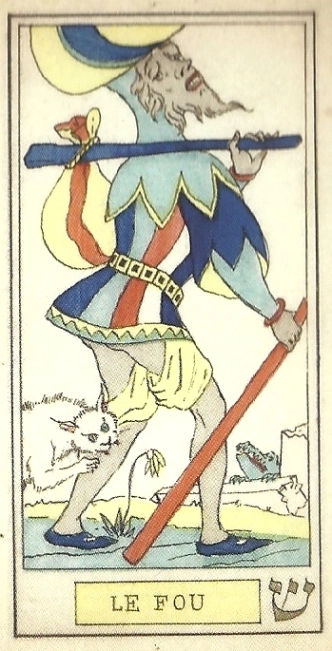
In the preface to his book, "Le Tarot, des lmagiers du Moyen" [Tarot - Pictures of the Middle Ages - published in Paris in 1926 and translated into English as "The Tarot of the Magicians" by Samuel Weiser in 1985], Wirth attributes his blossoming knowledge of Tarot to another young occultist, Stanislas de Guaita. Guaita admired Wirth's artistic talents and "advised [him] to restore the 22 arcanas to their hieroglyphic purity... The ideal to be realised demanded a perfect unity of symbolism, so that everything fits into the 22 compositions, which must throw light upon each other and must contain no arbitrary detail which is not justified." De Guaita established his Major Arcana as an initiatory sequence to be used to establish a path of spiritual ascension and evolution.
What is this if it is not what Cherisey himself adopted about a journey to find a spiritual tomb? And Plantard also must have been utilising the deck of the 22 arcana to establish a path of initiatory sequence which must throw light upon each other and must contain no arbitrary detail which is not justified!
Below - the Fool Card designed by Pierre Plantard for his own Tarot
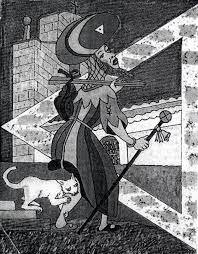
You can see in the background the church at Rennes-les-Bains with a cross and with a structure with a sphere on top of it. The Fool appears to have descended some steps which may hint of going below ground, perhaps under the church or perhaps below the ground in the cemetery as the orientation of the Church depicted on the card suggests that the Fool is in the cemetery at the side of the church [actually near the Fleury tomb]. This would fit with Chérisey's assertion that there is an extensive necropolis below the Grand Square in the village of Rennes-les-Bains.
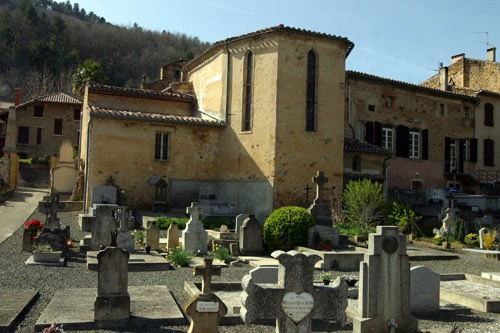
Above - this is a photo of the cemetery behind the Church at Rennes-les-Bains. You can see the belfry of the church - and the area to the left of the picture [by the side of the church] depicted by Plantard suggesting an underground access in this area.
We must remember that Beaucean remarks, when he is discussing whether a statue of Isis, also known as Venus, came from a Roman Temple under the village of Rennes-les-Bains, which he says the answer must be true because 'the discovery of a great charnel house under the main square seems to confirm it'.
A charnel house 'under the town square' i.e under the Place Deux Rennes?
Behind this main square Beaucean continues, is the church - to the South - where stood a huge pagan Temple from which the statue of an alleged Isis/Venus came from. Beaucean is saying that a pagan Temple stood here, before the church of Rennes-les-Bains. The geography referred to fits with the very real large block Roman foundations witnessed by Boudet and others in a specific area of this Grand Square, the Place Deux Rennes!
Four other painting composition's of these Tarot cards by Plantard were published in “Le Cercle” by his son Thomas in the BNF in 1992. They carry details which relate to Rennes-les-Bains and Rennes-le-Chateau. Below are the illustrations from Le Cercle as well as the original Wirth Great Arcana illustrations;
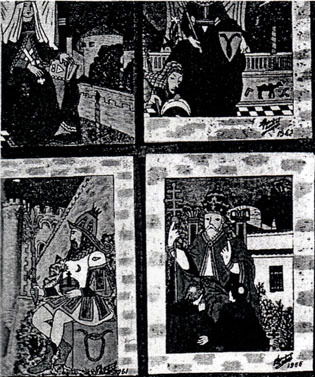
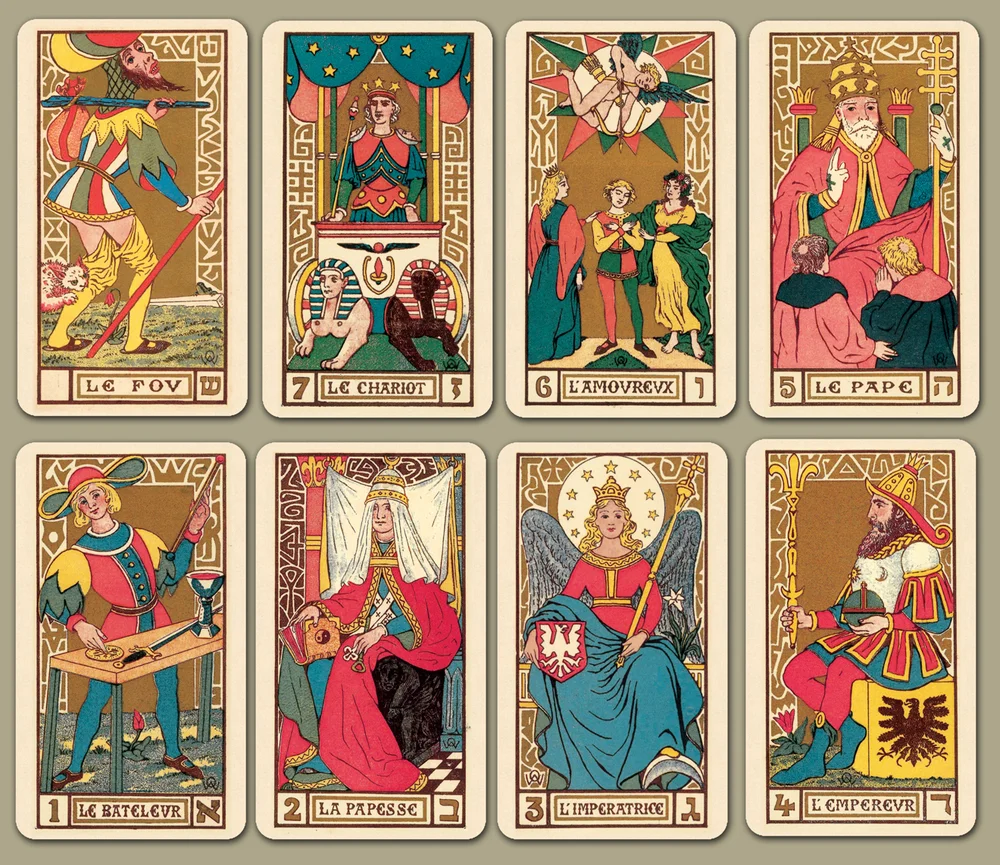
Chérisey and Plantard and their coded information about the Two Rennes
Chérisey was an extraordinary and under-rated poet and fantastic story-teller and he put it to good use in collaboration with Pierre Plantard. Plantard had access to occult files that carried strange information and both of them used literary devices in their respective publications to convey deeper meanings and to highlight important themes they had found out about.
We mentioned circumlocution but they also used transposition - a kind of time distortion and place distortion [we see this in Cherisey's novel CIRCUIT] - and by changing the relative place or normal order of a thing, or altering a known sequence of events the authors were drawing us in to some hidden knowledge they possessed. And using juxtaposition - i.e they put two things [facts or ideas] together with contrasting effect to illustrate something else entirely. Chérisey did this supremely well in his novel CIRCUIT. In the text 'In the Country of the White Queen' they did it to compare and contrast a similar legend between Gisors and Rennes-les-Bains about an underground Temple in both places both solidly attested to in archaeology.
IN THE COUNTRY OF Reine Blanche de Neaufles
Plantard and Chérisey transposed the local legend of an underground passage in a GISORS tower to one such legend at Rennes-les-Bains.
The legend in Gisors involved the tower of the Reine Blanche de Neaufles with its underground passage leading from it & which linked in some way with the main town of Gisors. This transplanted legend to an 'underground' place in Rennes-les-Bains will take us directly to Henri BOUDET.
Blanche D'EVREUX is the 'white queen' who retired to the Tower of Neaufles in 1359. Her 'whiteness' was described as befitting her when her husband died, and that when she was in mourning she dressed in white as opposed to the later black colour tradition. Her husband was Philippe VI, first king of France from the House of Valois, reigning from 1328 until his death in 1350. Having died without leaving any male heirs, the throne fell to a cousin from another line: Philippe de Valois. Philippe therefore wanted to consolidate his perhaps disputed royalty by marrying his son Jean-le-Bon, who had become a widower, to a descendant of the illustrious Saint Louis, the lovely Blanche de Navarre (also called Blanche d'Évreux, i.e the White Queen of the Neaufles tower).
In the legend of Neaufles an underground passage ends at the entrance of a cave of treasure guarded by a demon and access is granted on only one day of the year [December 25th]. In the collective memory of the locals, the links existing between Gisors and Neaufles are marked by belief in this underground passage which supposedly connects the two fortresses of Gisors and Neaufles.
The legend of this underground tunnel is reinforced by the presence in the town of a "monumental cross" in limestone, called the "pierced cross", carved in the middle of the 12th century.
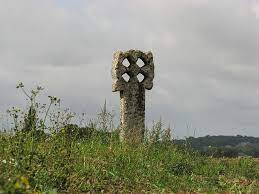
Above - Pierced cross of Neaufles-Saint-Martin famously used by De Sede on the cover of his 'The Templars Are Among Us'.
Another variation on this legend says that Neaufles & Gisors are at the centre of a mysterious knot of underground passages whose route, in the region, is marked by Templar crosses tracing their passage above ground.
In the 19th century, a worker was sent to inspect these underground areas of Neaufles to see if any consolidation work was required. He walked through the galleries for a long distance, before arriving in front of a heavy, rusted iron gate, behind which, at the back of a room, he could see glittering objects and gold coins. He decided to tackle this solid gate, kept closed not only by its strong lock, but also by the rust that covered it. While he was engaged in this operation, there was a terrible crashing noise, as if from hell, which filled the galleries and caused him to panic. He quickly turned back and, sure that he had crossed paths with the devil, refused to descend into the sinister trenches again.
This legend has an echo in those legends of Rennes, especially with the involvement of a demon or Devil. I think in particular of the Devil's Treasure at Blanchefort and/or the Shepherdess treasure of Le Serbairou.
A slight variation on this same legend is one called Le souterrain de la Reine Blanche which reports that the underground passages of the Neaufles tower and it's ruined fortress are located one league from the castle of Gisors & that they communicate with each other, as usual, by way of an underground passage which passes under the river bed which separates the two places. The passage conceals a magical treasure, locked up under iron gates of marvellous workmanship. The legend reports the testimony of a worker who, having worked in the underground passages of Neaufles, claimed to have seen and touched these beautiful gates. They formed an impenetrable barrier which defended the entrance to a magnificent temple [my emphasis]. This temple was dedicated to the Golden Calf, whose resplendent image rose at the bottom of the sanctuary. A heap of riches, to put off the greedy, was spread at the feet of the impure idol. Gold, silver, diamonds & precious stones were displayed in profusion on the walls and ceilings of the temple. The workers who had received the order to clear the underground passages to get to this underground Temple at Gisors, tried to penetrate under the dark vaults, but were forced to interrupt their work: flaming chasms opened up under their feet; the air around them was impregnated with fetid vapours; hideous apparitions appeared before their eyes, and they heard a dreadful angry hell roar in their ears! On reading the genealogy of Christ at midnight mass, the iron gates of the underground Temple opened silently, while the Golden Calf and its satanic riches are delivered, defeated and defenceless, to the hand that would dare to seize it!
For Beaucean and by extension Plantard and Chérisey this legend of an underground Temple at Neaufles/Gisors was transposed with one at Rennes-les-Bains - also directly associated with a White Queen - but their white queen was in fact a statue! They also link a kind of astrological reading to the placement of the Gisors castle and Chateau and presumably a celestial zodiac, another feature linked by Plantard to Rennes-les-Bains. Both zodiacs are applied to the landscape that they are in. There are also echos of flaming chasms ... under their feet; the air around them was impregnated with fetid vapours at Rennes-les-Bains, because as an ancient Roman spa town all sorts of hot water vapours are seen there, even to this day!
Beaucean carries on with his tale, writing;
"By collecting many documents, historians were able to establish the precise location of a white marble statue measuring over two meters in height & representing ISIS. Here the testimonies diverge. Some say that the tests carried out at the place indicated brought back dust of white marble, others that the exhumed goddess was immediately re-buried, others finally that the research is entirely imaginary. The owner of the Hotel has not been heard from because we are certain that a man has the right to bury ISIS in his yard without reporting it to anyone."
THE WHITE MARBLE STATUE AT RENNES-LES-BAINS
Beaucean has taken this information from an historical work by Dr Paul Courrent. Courrent wrote a lot about the history of Rennes-les-Bains saying that;
"Paul Urbain de Fleury and his son Henri ... created a small local museum with the discoveries found at Rennes at different times but especially at the beginning of the eighteenth century, & they have long been kept in the cabinet of the Fleury's. They include: fragments of brick and tile edges which are Gallo-Roman; a beautiful white cornice fragment of marble and an ornament plate of 45 mm. There are also remains of statues, artistically made, including;
i) a complete arm with a hand holding an egg, white Marble, 0.60 centimetres
ii) an arm holding a snake wrapped in a patôre, white marble,
iii) a hand gripping a cloth/linen, marble. The latter should be compared to an ornate hand with rings also holding a piece of cloth, of which other examples have been found in the ruins of a temple on the Seine.
Marius CATHALA the learned archaeologist and palaeontologist, former president of the Society for Scientific Studies of the Aude, personally believes in the existence of the statue to which the hand with the egg belonged. He even locates the presence of this statue in the furnished hotel CHALULEAÛ at Rennes-les-Bains, in the middle of an exterior courtyard, where soundings carried out by himself, brought up marble dust which he believes to have come from this statue. This hotel is built on very old substructures. We do not want the owner of this hotel to continue to oppose any research - how interesting it would be, if it is true that the statue exists, to bring it to light and place it on the square of our station!" [i.e the Place Deux Rennes, my emphasis].
As we shall see below it is the complete arm with a hand holding an egg, white Marble, 0.60 centimetres which is of interest [as drawn by a local historian and shown below].

The interesting observation is that the owners of the Maison/Hotel Chaluleau at the time of Courrent appeared to obstruct the early wannabe archaeologists from excavating which he finds a source of great frustration - and this is even in the knowledge that the Fleury's themselves were already collecting artefacts and displaying them. The displayed artefacts actually came from this same hotel/maison/house. We do indeed wonder why the owners of the House would obstruct the archaeologists when finds were already being made and displayed in the Fluery cabinets!

Above - Marius CATHALA
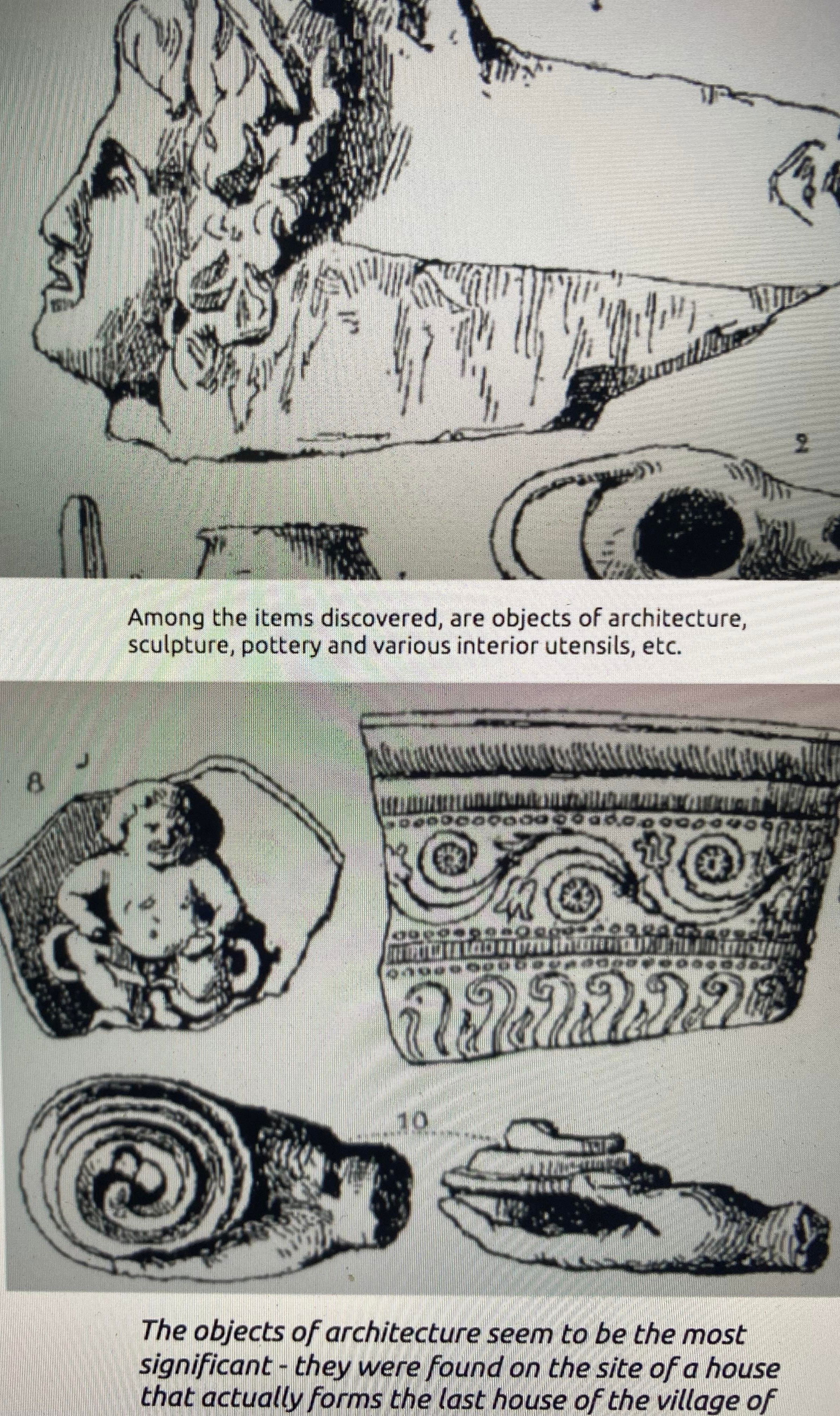
However, Courrent in his piece, seems not to be aware of the rumours of the finding of another statue, that of the goddess Venus, apparently found in the same place and later sold off to an American. This statue of Venus has direct links to Henri Boudet.
Courrent continues;
"The Chaluleau hotel also seems to be built on very old substructures. Repairs carried out in this house in 1928, revealed "large block foundations" that Mr. ROUZAUD, former president of the Archaeological Commission of Narbonne, attributes to ancient Roman buildings, temples or palaces'.
These 'very old substructures' seen by Courrent and ROUZAUD were seen much earlier in 1862 by Monsieur Cumenge, who wrote:
"The temple of Rennes, of which I recognised the traces, the paving stones, the walls and various votive altars, still lay under a layer of plant soil at a depth of one meter and 50 centimetres. The pavement of the temple is made up of large slabs of 50 cent. thick, 25 wide by 35 long."
This testimony is fascinating because Cumenge calls these Roman remains the Temple of Rennes. He sees paving stones, walls and 'various' votive altars. This means that beneath our very own feet, when we visit Rennes-les-Bains approximately one meter down, these remains are still there!
Cumenge could see votive altars associated with the Temple. He continues;
"It was while digging foundations and clearing the ground that we found the arm of a woman, holding an egg in her hand [my emphasis] which she appears to be presenting to those present. It was the symbol of the divinity of these places dedicated to fertility, a belief which has continued to this day and which still makes people ask Rennes every year for the fulfilment of the dearest wish of a woman.... Aesculapius was still the God that people came to implore in Rennes. Certainly, if excavations were carried out in this place rich in archaeological treasures, we would find the body of this statue [my emphasis]. We would see to which foot a big toe in white marble, which was broken by an unskilled workman, belonged. We would find the rest of this inscription. For which altars did these marble mouldings serve as ornaments and bases? I promised myself that one day I would see again this land which is not yet invaded by the habitations."
Gourdon writes about other finds associated with the arm - " ..... several sizeable fragments of capitals, columns, etc., of remarkable work, in which it is easy to recognise the debris of a temple, dedicated either to Aesculapius or Hygeia. Cumenge unfortunately does not explicitly state where 'digging of these foundations' took place and whereabouts in the village of Rennes-les-Bains he exactly saw the Temple of Rennes. But he is an eyewitness to the finding of the 'arm of a woman, holding an egg in her hand'. Cumenge published his account in 1862, therefore the excavations must have taken place earlier. We know another chronicler, Gourdon sited the finding of an arm holding an egg [and supplying a drawing as detailed above] on the site of a house that actually forms the last house of the village of Bains, to the South. And we know that Dr Courrent described the finding in the hotel CHALULEAÛ.
This is virtually the same thing Cumenge wrote so perhaps Gourdon was there/saw it/knew Cumenge and was there at the same excavation? And importantly, we know where Gourdon was talking about. It was the area of Maison Chalaleu and the church at Rennes-les-Bains and the main square of the village. We know that the Maison Aveilla/Chaluleau-Cathary was built in 1860 and so foundation excavations around that time must be associated with these archaeological findings.
Both Gourdon and Cumenge were on hand, and were able to report what they saw a few years later.
It is quite clear that the Maison Chaluleau environs and perhaps further afield is where the foundations of a probable Roman Temple exists and I suspect where a statue, of either Isis [for some] or Venus [in the eyewitness reports] was found. The arm with an egg statue, or perhaps another statue also came from this Temple and it's foundations.
Gourdon as local historian had already drawn a diagram of the statue's arm 'with a hand holding an egg' [as well as other items] as the illustration above shows. It is sometimes described as a votive offering but could it be possible that the hand holding an egg was part of a much larger statue as Marius CATHALA believed, and in fact as Cumnege believed? Cathala located the presence of the rest of the statue in the 'courtyard' of the maison CHALULEAÛ, in fact in the middle of its exterior courtyard.
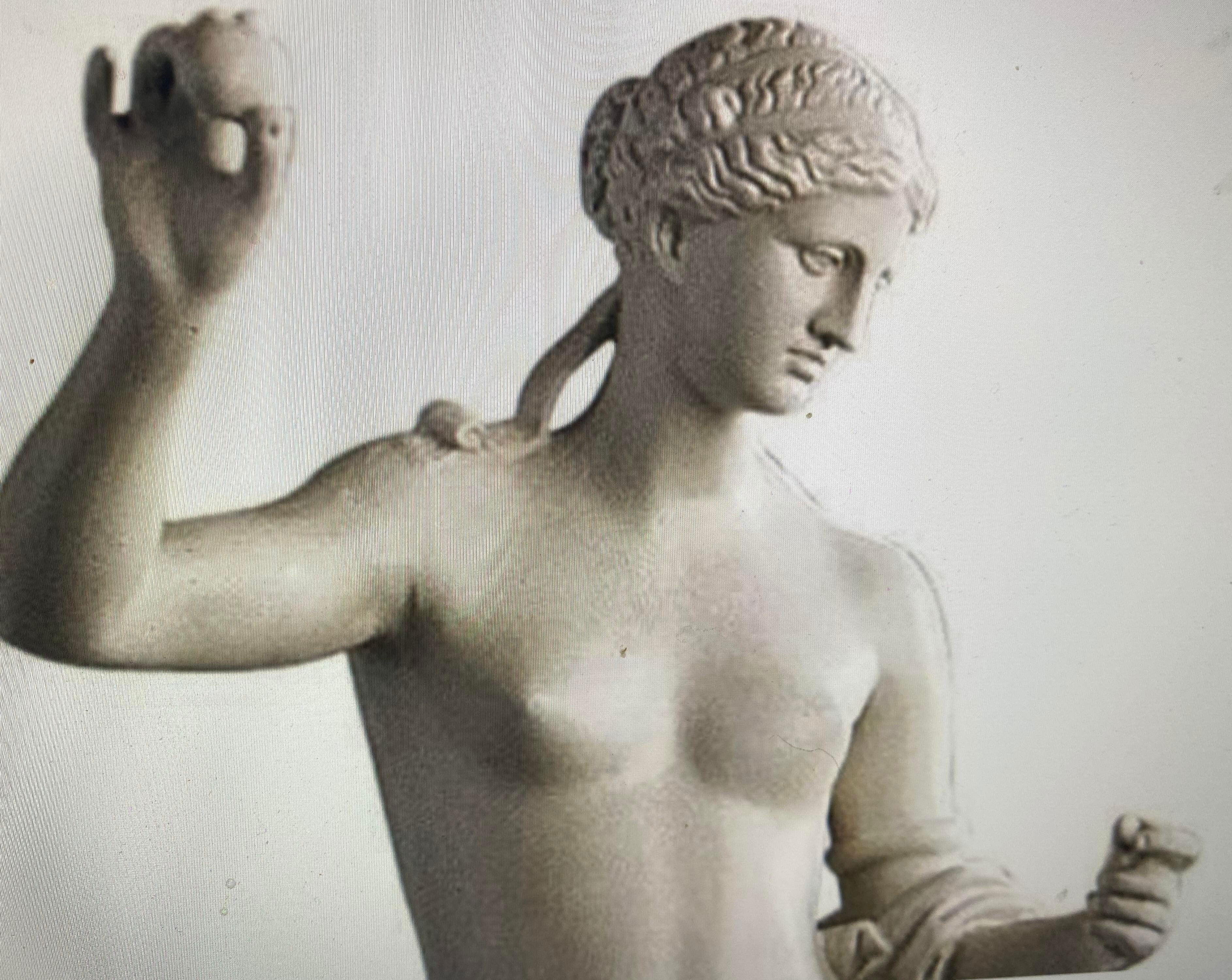
Above - a marble statue of Venus/Aphrodite holding an egg/?apple [Louvre Museum]. Did the White Queen statue of Rennes-les-Bains resemble this?
As i noted above this seems to be related to a witnessing of the finding of another statue in the very same courtyard by Henri Boudet, our archaeologist priest. Boudet discussed this find with Henri ROUZAUD who was a friend of Cathala and who visited Boudet at Rennes-les-Bains in around 1911 - these people were the same individuals interested in the Temple/Maison Chaluleau.
All of this is certainly the source of the literary output in the BEAUCEAN text. Therefore the paradigm we should be following is this information about a Temple at Maison Chaluleau. If you cross-reference this assumption with ideas promulgated by Plantard's Priory documentation one discovers that a juxtaposition is being made between a buried goddess/female figure associated with a fragrant tomb which is also associated with a white queen and a sacred sepulchre and statue buried below Maison Chaluleau, as described perhaps in the poem Le Serpent Rouge. The pilgrimage of the traveler and poet in Le Serpent Rouge superficially appear to be a visit to this underground place and Temple at Rennes?
Cherisey later wrote in his novel CIRCUIT the following;
"[...] CRITIAS – Il y a une statue d’Isis, ou de la Reine Blanche, ou de Notre-Dame, comme vous voulez. Elle a servi de modèle à la Vénus d’Ille décrite par Prosper Merimée qui l’a donné en bronze alors qu’elle est en marbre blanc. La statue mesure deux mètres de haut mais vous ne la verrez pas, enterrée qu’elle est dans une cour d’hôtel et prouvée seulement par la poudre de marbre que l’on a ramenée d’un sondage [...]"
CIRCUIT de Philippe de Chérisey,cap. XIV – LA TEMPERANCE
"[...] CRITIAS – Revenons donc à ce chapiteau qui sera planté au sud du village, sur la rive gauche de la Sals, au-delà du cimetière, après la grand’place et l’église. Ici se tenait un temple paien haut de quinze mètres qu’incendia Charles Martel en l’an 737 lors de sa tentative d’invasion du Languedoc. Outre la statue d’Isis, alias Vénus d’Ille, qui en provient, les autres reliques sont une tête de Mercure et une de Jupiter, un bras tenant un linge, une main tenant un oeuf, sans compter le charnier sous la grand’place. Ces renseignements proviennent des « Mémoires de l’abbé Delmas qui, ayant fait couler beaucoup plus de salive que d’encore, sont perdus depuis plus d’un siècle. Ont-ils jamais existé, existent-ils encore ? Prestidigitation [...]" CIRCUIT de Philippe de Chérisey , cap. XV – LE DIABLE "[..]
which is translated thus;
CRITIAS - There's a statue of Isis, or the White Queen, or Notre Dame, however you like it. She served as a model for the Venus of the Island described by Prosper Merimée who gave it in bronze while it is white marble. The statue is two meters high but you won't see it, buried in a hotel courtyard and proven only by the marble powder that we brought back from a survey [...]
Circuit of Philippe de Chérisey, cap. XIV - TEMPERANCE
"[... ] CRITIAS - So let's go back to this shrine .... planted in the south of the village, on the left bank of the Sals, beyond the cemetery, after the grand square and the church. Here stood a fifteen-meter-high Pagan temple that Charles Martel burned in the year 737 during his attempt to invade Languedoc. In addition to the statue of Isis, aka Venus of the Island, which originated from it, the other relics are a head of Mercury and one of Jupiter, an arm holding towel, a hand holding an egg, not counting the hinge under the grand square. This information comes from the "Memoirs of Abbot Delmas', which, having spilled much more saliva than ever, have been lost for more than a century. Did they ever exist, do they still exist? [...]. ]"
Circuit by Philippe de Chérisey, cap. XV - THE DEVIL
There is so much Chérisey is imparting here. The statue is from a shrine, one on the left bank of the Sals 'beyond the cemetery, by the grand square and the Church'. This Temple was burned down by Charles Martel. But is the Temple overground or underground? Cumenge had reported the foundations of THE Temple at Rennes at a depth of 1.5 metres. It must be possible that structures remain overground as it were.
In 'The Land of the White Queen' Beaucean also proposed that this statue, this White Queen was associated with a mysterious perfume - a language uncannily similar to descriptions of a perfumed tomb described in the poem Le Serpent Rouge. Beaucean wrote that BLANCHE D'EVREUX, practised alchemy in the NEAUPHLES tower, in the company of Nicolas Flamel, a famous bookseller and manuscript copyist. Presumably the alchemical experiments were the source of this mysterious perfume? Flamel was not a religious scholar or even royal as were many of his predecessors and his entire interest in the subject of alchemy revolved around the pursuit of the philosopher's stone [in it's original form alchemy can be interpreted as the process of transmutation by which to fuse or reunite with the divine or original form]. In Le Serpent Rouge the mysterious perfume was not associated with alchemy but with a sepulchre [....a sweet perfume rising towards you as it permeates the sepulchre"].
Using our Owl's inner ear and insight does this white queen somehow represent a sacred body of a female and that if you can smell the sweet perfume emanating from her you are near her sepulchre?
There is no doubt in my mind that Chérisey is referring to a 'shrine' found 'beyond the cemetery and after the grand square and the church' at Rennes-les-Bains. This shrine was originally perhaps to be found in a fifteen metre high Pagan Temple - probably later used as the old Roman Temple of Rennes - whose substructures Marius Cathala 'could make out' under the Maison Chalaleu during the building projects at the time of Boudet. Chérisey says it was a pagan Temple, which was burnt down by Martel. The reference to Charles Martel is interesting, because as we know by now, Chérisey always says something for a reason!
It is in the Continuations of Fredegar that Odo [or King Eudes] was defeated by the army of Charles Martel at the Battle of Tours. Martel had invaded the Languedoc as part of his plan to expel the Moslem occupation of the area and presumably Chérisey is linking this invasion to the burning of the Temple of Rennes to this? This King Eudes is also linked to the body of Mary Magdalene! In legend he is the person who rescued her body from this Saracen Invasion.
Eudes had called on assistance from the recently established emirate of al-Andalus, and it is likely that the invasion or raid by Charles Martel took place in revenge for Eude's support for rebel Berber leader Munuza. Eudes [or Odo] is a very interesting character. He was the Duke of Aquitaine by 700. His territory included south-west of Gaul and the Duchy of Aquitaine a realm extending from the Loire to the Pyrenees, with the capital in Toulouse. He fought the Carolingian Franks and made alliances with the Moors to combat them. He retained this domain until 735. He is remembered for defeating the Umayyads in 721 in the Battle of Toulouse. He was the first to defeat them decisively in Western Europe. The feat earned him the epithet "the Great". He also played a crucial role in the Battle of Tours, working closely with Charles Martel, whose alliance he sought after the Umayyad invasion of what is now southern France in 732. His earlier life is obscure, as are his ancestry and ethnicity. One theory suggests that he was of Roman origin as contemporary Frankish chroniclers refer to his father as an enemy Roman.
The historian Jean de Jaurgain cites him as fighting in 711 against the Visigoth Roderic. In 715 he declared himself independent during the civil war raging in Gaul. It is not likely that he ever took the title of king. In 718, he appears raising an army of Basques as an ally of Chilperic II of Neustria, where Mayor of the Palace of Ragenfrid may have offered recognition of his kingship over Aquitaine. They were fighting against the Austrasian Charles Martel but after the defeat of Chilperic at Battle of Soissons (718) he made peace with Charles by surrendering to him the Neustrian king and his treasures. In order to help secure his borders against the Umayyads, he married his daughter Lampegia, to the Muslim Berber rebel lord Uthman ibn Naissa, called "Munuza" by the Franks, the deputy governor of what would later become Catalonia. Charles Martel denounced Odo's alliance with Uthman ibn Naissa, and crossed the Loire, so breaking the peace treaty held with Odo. Charles Martel ransacked Aquitaine twice, seizing Bourges, too, and Odo engaged the Frankish troops but was defeated.
The reason I mention much about Eudes/Odo is that he is indeed associated with the rescuing of the body of Mary Magdalene from the Saracens. And Chérisey appears to be adopting a transposition programme here! He writes about;
- a statue of Isis, or the White Queen, or Notre Dame, however you like it.
- The statue is two meters high but you won't see it, buried in a hotel courtyard
- this shrine .... is planted in the south of the village, on the left bank of the Sals, beyond the cemetery, after the grand square and the church.
- Here stood a fifteen-meter-high Pagan temple that Charles Martel burned in the year 737
- In addition to the statue of Isis, originating from this fifteen meter high pagan Temple, came other relics - a head of Mercury and one of Jupiter, an arm holding towel, a hand holding an egg, not counting the hinge under the grand square.
When you cross reference this history of Charles Martel and King Eudes with the writings of Cherisey, it is being asserted that Martel burnt down the Temple and in this Temple Chérisey is saying the statue of the white queen was found and it was from a shrine, a shrine on the left bank of the Sals 'beyond the cemetery, the grand square and the Church'. But a shrine to who? Presumably Mary Magdalene? Perhaps we will see when we investigate the 'invention of the relics by the Anjou family [already mentioned above] of Mary Magdalene in the Middle Ages?
"Charles, Prince of Salerno, is the son of Charles of Anjou, Count of Provence, and therefore the nephew of King Saint Louis. He is himself the father of a saint, Louis de Brignoles, bishop of Toulouse. He wishes to update the evidence of the existence of the tomb of Mary Magdalene in Provence.
To carry out his research, he went to Aix, studied the history books and the annals. He also questioned the old men about the local traditions which provide the scout.
Charles II thus acquired the certainty that Saint Maximin had buried the body of Magdalene in the church of the small town which bears his name. He therefore went there with his suite, in December 1279. He gives order to make excavations, they visited the tombs, the walls and the floor of the church … They ended up reaching the crypt, walled and filled with soil.
Finally, on December 9, the prince, said the chronicler, "had stripped his chlamyde, and, armed with a hoe, he dug the earth with such ardor that he was inundated with sweat, those who were met a marble tomb worker ”. They tried to open it; immediately a wonderful odor escaped. And so, the audience think that the body they saw was the treasure they were looking for".
These are the facts which constitute the “invention” of the relics. The word comes from the Latin word “invenire”, that is to say to discover, find, and not to invent.
In the dust of the tomb the Prince found a piece of old cork containing a small parchment with a Latin inscription
“The year of the Nativity of the Lord 710, 6th day of December, at night and very secretly, under the reign of the very pious Eudes, king of the French, at the time of the ravages of the treacherous Saracen nation, this body of the very dear and venerable Saint Marie-Madeleine was, for fear of the treacherous nation, transferred from her alabaster tomb to this marble tomb, after having removed Sidoine’s body from it, because it was better hidden there ”.
The Prince drew up an act of relating these facts and sealed the tomb" [HERE]
So here are elements of the Chérisey's transposition;
- the statue found in his Au Pays le la Reine text is a metaphor for a real body
- the statue was found in the courtyard of Maison Chalaleu
- Maison Chalaleu was built over/or reused remains from the Temple of Rennes, perhaps originally a pagan site which was burned down by Charles Martel
- the context of the Martel flagaration was the Saracen invasion of the Languedoc in the 710's/720's
- Charles Martel fought with King Eudes of the Aquitaine in these battles
- King Eudes during the battles rescued the body of Saint Mary Magdalene from the Saracen invasion
- Years later Charles, Prince of Salerno after carrying out a historical and archaeological survey found the tomb of Mary Magdalene and upon opening the tomb "immediately a wonderful odor escaped".
- This odor is associated, by those present at the opening, with the perfume which St Mary Magdalene poured on the head and feet of Jesus before his death.
- This odor and tomb is connected in the poem Le Serpent Rouge; From her that I wanted to free, rose towards me the emanations of perfume which permeate the sepulchre. Once some called her: ISIS, queen of the beneficent springs
The continued garbled references to Roman temples and statues that have been seen by some, including Henri Boudet, seem to be related also to local village gossip. Local villagers have reported via oral legends that Boudet - together with his family - had started to hide artefacts under a house built in the middle of the village - a house that was associated with him. If correct, this suggests a deliberate policy by Boudet of looking for artefacts 'around Rennes' [i.e he found them during the course of his rambling walks or perhaps knowledge he was already aware of. Think of his comment in his book, La Vrai Langue Celtique. He wrote that he was: trying to penetrate the secret of a local history' ]. This activity may link Boudet to another verse in Le Serpent Rouge about the pillaging of artefacts viz:
[Scorpio]
... But how many times have they sacked the HOUSE, leaving only the embalmed corpses and numerous metal objects which they could not carry? What strange mystery conceals the new temple of SALOMON built by the children of Saint VINCENT? [my emphasis].
In this scenario the sacked HOUSE would be Maison Chalaleu. It seems that Boudet was, in fact, not 'hiding artefacts under a house built in the middle of the village'. More likely it was that villagers were present when these artefacts were found when foundations to a house associated with him were being dug and which became the subject of village gossip. It makes one ask the question - where would Boudet be taking artefacts from, to hide under a house associated with him in the village? And how did he know about these artefacts? The house associated with Boudet at Rennes-les-Bains was in fact CHALULEAU as we shall see below. It is probably where Boudet got the famous gourd from the 5th or 6th century; with stamped Christian cross. Boudet offered this to Mr. ROUZAUD, member of the Archaeological Commission of Narbonne, an object discovered in the village.

So how is it that Dr Courrent missed writing about the white statue found by the priest of the village of Rennes-les-Bains? The statue of Venus? And how is it that the Abbe Delmas [a prior priest of Rennes-les-Bains] did not talk of these artefacts at all, instead speaking of the tomb of a mysterious and grand Roman who had died in the vicinity of Rennes-les-Bains, which he linked to the great Roman general, Pompey!
Urbain GIBERT reported in his "Notes Historiques sur les Bains de Montferransd devenues les Bains de Rennes, Actuellement Rennes-les-Bains about the statue of Venus associated with Abbé Henri Boudet. The incident was said to have occurred in the maison Chalaleau at the beginning of the century. It was a beautiful statue but Boudet found it 'demonic". Gibert writes;
"Boudet, did not not want to preserve it - an archaeologist from Beziers took it. It was later sold in America'. [The information was collected by Mrs. Martin-Duclos, of Rennes-les- Bains)". Another witness, a M. Certain (of the Mémoires de la Société des Arts et des Sciences, Carcassonne, 3rd series, t.VII) also recorded the find. He reported that "...40 years ago, the cure of Rennes-les-Bains, M. Boudet, found in the excavations at (maison Chaluleau) a statue of Venus."
There is a problem.
The arm holding an egg thought to be related to a statue found at Maison Chaluleau - was drawn and reproduced in the work of Dr Jean Gourdon, Stations thermales de l'Aude which was published in 1874. Boudet arrived at Rennes-les-Bains in 1872, aged 35. If it is the same statue - the original finding 'of the arm of this statue' of Venus presumably would have taken place between 1872 and 1874!
Gibert however reports that a/the statue was found 'at the beginning of the century ....." [ie 1900's] then M.Certain records the find as one that took place '40 years ago' - making the discovery in the 1930's - however Boudet was long dead by then!
Are we talking about the same statues, or a muddling of events of the finding of different statues, or even deliberate obfuscation? However it would seem there were two statues of Venus as Jean-Luc Chaumeil and Jacques Riviere in “The Solar Alphabet” page 107 wrote;
"... around 1900, reports M.U. Gibert, in 1973, Abbe Boudet discovered in excavations a beautiful marble statue of Venus. The abbot found this demonic statue and did not wish to keep it. An archaeologist from Beziers took it. Another statue of Venus, naked, discovered in the excavations of the Maison Chaluleau in Rennes, remained buried on the orders of 'Abbe..."
So a Venus statue found by Boudet remained buried 'on the orders of Boudet'. We have no description of the Boudet statue of Venus. Cathala's arm of the [a?] statue found in Chaluleau - to be precise in the exterior courtyard of the hotel associated with Boudet - has similar details and information regarding the finding of the Boudet statue in the same property. Is it the same statue or a different find of another statue, or even several statues found in a Temple complex, perhaps from underground?
Anyway, Beaucean, after describing all this archaeology at Rennes-les-Bains, then observes that glottologists had arrived at the deplorable conclusion that the word “Reine” had been confused with the word “Rennes” and therefore a white bath of Rennes had in fact been confused with a White Queen of Rennes.
This again signals the use of the language of the birds and the beginning of a transposition.
Nicolas Beaucéan just prior to this observations had written;
"The post cards which showed the bathing tub of Queen Blanche at Rennes-les-Bains were printed in their thousands. However, since the 39/40 war no more were published. The object itself has disappeared, but of the forty bathing tubs which are included in the furniture of the thermal station, no-one knows exactly which one received the precious body of the sovereign. Similar bathing tubs have been seen in all the thermal establishments. This one is in marble, squat, in no particular style - this allows it to be dated. A Celt could have sculpted it, but so could a manufacturer from the last century. This anonymity gives it a certain beauty and surrounds it with mystery ....."
He continues:
"... the grammarians proposed this deplorable conclusion, namely that "Reine" had been confused with "Rennes" and a white bathing tub [which the ancient curists had used - my addition] at Rennes with a bathing tub of la Reine Blanche (the White Queen), so the mystery turned to the thermal station's past. A work of 1886 proposed placing Rennes-les-Bains at the centre of a cromleck measuring 16 to 18 kilometres long. Here was situated one of the high spots of the Celtic civilisation.'
So now this archaeology and bath tub somehow relates to Henri Boudet and his imagined and non-existent Cromlech. Not only that - it is the centre of this Cromlech - and we know Boudet describes two circles around Rennes-les-Bains. Which circle is the centre of importance?
Beaucean is using homophony to get his point across. He describes the frequent bath tubs the curists used at ancient Rennes and he mentions postcards which represented at least forty of these bathtubs at Rennes-les-Bains. The postcards, he notes, stopped being published in 1939-40. There is even a reference that the bath tub that held a/the white Queen [a statue or a real female body?] could just as well have held the body of an ancient Celtic princess as well as our more modern queen because it was so well preserved and had a certain 'anonymity'.
The aural connection to be made via the words reine/Rennes and transposition seems to be the idea that a buried white bath-tub of ancient times held a real historical white queens' body juxtaposed with a buried white queen which really was a buried statue at Rennes-les-Bains perhaps later associated with this bath-tub! But since when did the Maison Chalaleu have bath-tubs associated with it - surely this would be more associated with the spa areas of Rennes-les-Bains, of which there were several? And is the question, therefore, via wordplay - whether the buried white Queen/statue and buried white bath tub at Rennes still holds a body, whether real or a statue, of some great importance which marks the centre of Boudet's Cromlech?
There are several questions to ask here. We already know the statue of Isis was likened to the Statue of Venus, and that the Statue of Venus for Beaucean was found in the courtyard of Chalaleu. This statue seems to represent a very real but sacred other body. And Beaucean decided that the discovery of a charnel house under the main square at Rennes-les-Bains would confirm it!
But why? Why does this confirm it and when was this great charnel house discovered? [A charnel house is a building or vault in which corpses or bones are piled up. It can be a place associated with violent death].
And it would seem Cherisey has been here because he describes his visit to it in the last chapter of CIRCUIT. This old Roman Temple somehow housed a shrine - from the Latin scrinium which means a "case or chest for books or papers"; (Old French: escrin "box or case"). A shrine is also a sacred or holy space dedicated to a specific deity, ancestor, hero, martyr, saint, daemon, or similar figure of respect, wherein they are venerated or worshipped. Shrines often contain idols, relics, or other such objects associated with the figure being venerated.
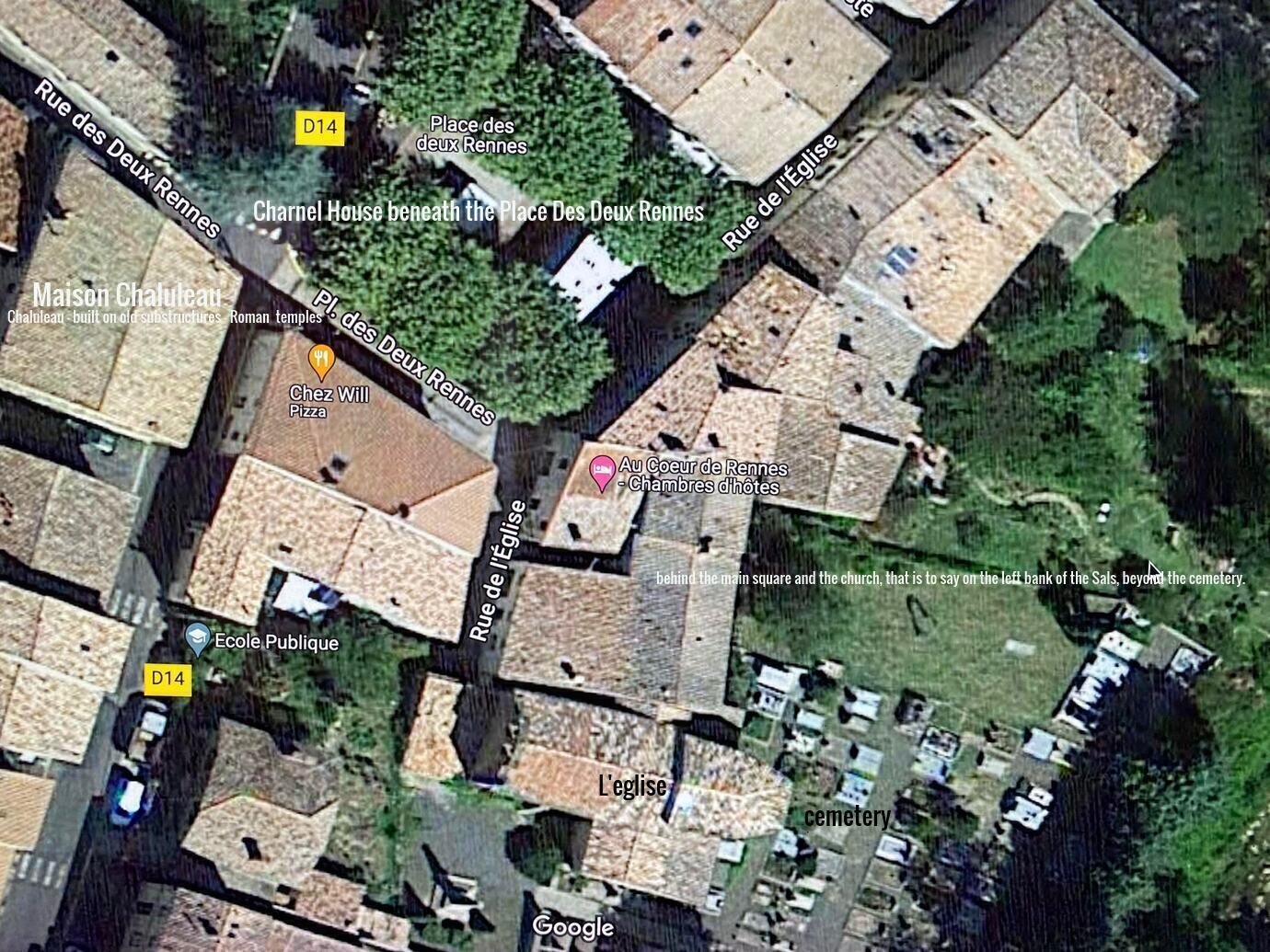
Above - the areas we are referring to in the text
There are two versions of the Beacean text,
One is written by Anne-Léa Hisler and the other by Nicolas Beaucéan.
It is interesting that Plantard's first wife may have written a version of this text, as she had certainly written about her husband Pierre Plantard before. [She may even be referred to in CIRCUIT via the Anne character, the novel by Cherisey]. It is the Anne-Léa Hisler text entitled 𝑇𝑟𝑒́𝑠𝑜𝑟 𝑎𝑢 𝑝𝑎𝑦𝑠 𝑑𝑒 𝑙𝑎 𝑅𝑒𝑖𝑛𝑒 𝑏𝑙𝑎𝑛𝑐ℎ𝑒 - 𝐻𝑖𝑠𝑡𝑜𝑖𝑟𝑒 𝑒𝑡 𝑙𝑒́𝑔𝑒𝑛𝑑𝑒 𝑑𝑒 𝑅𝑒𝑛𝑛𝑒𝑠-𝑙𝑒𝑠-𝐵𝑎𝑖𝑛𝑠 𝑒𝑡 𝑑𝑒 𝑅𝑒𝑛𝑛𝑒𝑠-𝑙𝑒-𝐶ℎ𝑎̂𝑡𝑒𝑎𝑢 (𝐴𝑢𝑑𝑒), where it is explicitly stated;
"The thirst for mystery was about to be further disappointed when the REINE BLANCHE reappeared no longer in a bath, but under the earth of a hotel courtyard!"
The association is thus made between this white queen and a buried bath tub and a buried statue 'under the earth' of a hotel courtyard - and as we have seen the courtyard is that of Maison Chaluleau.
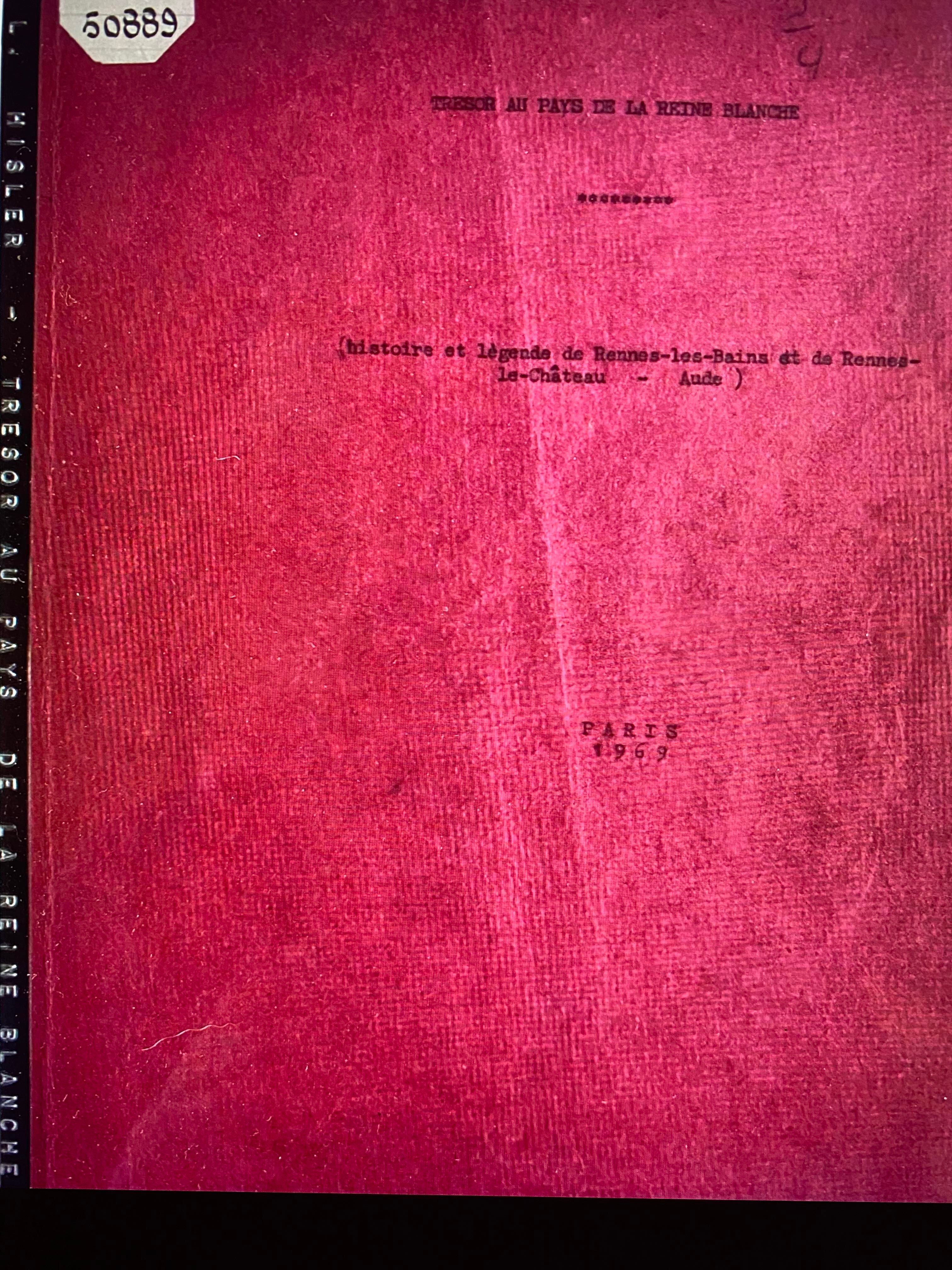
Above - document in NATIONAL LIBRARY of France by Anne Le-Hisler about the 'country of the White Queen'.
Essentially the two texts tell the same story with some interesting variations. Beaucéan wrote: En rassemblant des foules de documents les historiens purent établir l'emplacement précis d'une statue de marbre blancmesurant plus de deux métres dehaut et représentant ISIS. His reference for his statement was cited as Docteur J. GOURDON's - Stations Thermales de l'Aude - published in 1874 [& to which we have already mentioned] - you can see this detailed at the bottom of the page in this photograph below.
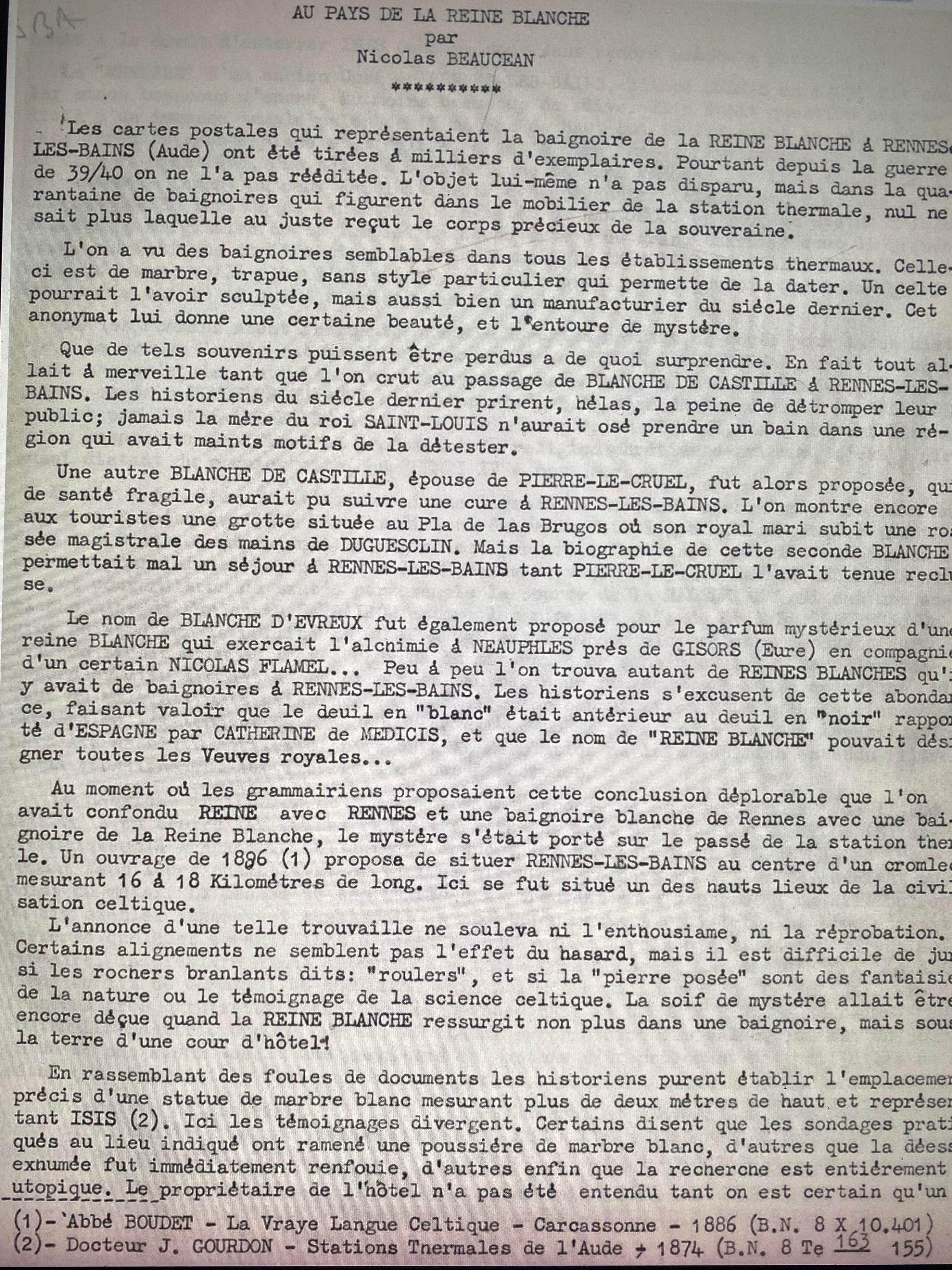
Above - document in NATIONAL LIBRARY of France by ?Philippe de Chérisey about the 'country of the White Queen'.
Docteur J. GOURDON's - Stations Thermales de l'Aude
In this book Gourdon wrote:
"... in several points of the village today, mainly in the part between Bain-Fort and the hamlet of Le Cercle it has been recognised, at various depths, a great quantity of remains of Roman buildings: constructions of buildings, fragments of mosaics, etc, which may have been part, either of private houses/villas or monuments of another order. The literal space occupied by these objects indicates an extended and fairly large city, in the Valley, spread out to the broader and more Southern area of the village. In this Valley, there was seen, in the middle of a cultivated field, the site of a square house, recognisable from the lines and 'crop marks' found in the vegetation where it was much less bushy than in the corresponding parts of older buildings. It is at this point especially there have been found in the ground raised by agricultural implements, a huge amount of debris of all kinds, most covered with a layer of ash and charred fragments, testifying to the destiny of this ancient city, which, at the time when the whole country was ravaged by barbarians, was destroyed by fire. From this its prosperity disappeared and so did its fame and its name'.

Above - the general area Gourdon identifies as where the majority of the significant finds were made.
The 'barbarians' mentioned by Gourdon surely refer to the barbarian Arab invasion, under Al-Samh ibn Malik, who was the governor-general of al-Andalus at the time, and who swept up the Iberian peninsula by 719 and overran the area of Rennes. We referred to this above with King/Duke Eudes.
This is the historical event referred to when the Priory text mentions a pagan Temple [i.e pre-Christian] and that Charles Martel did not not burn it down which suggests it was still standing in the 8th century. Boudet also references it and includes a head he found and saved, on a local landmark, Cap de L'homme.
Gourdon continues:
"... Among the items discovered in the above cited circumstances, are objects of architecture, sculpture, pottery and various interior utensils, etc. The objects of architecture seem to be the most significant - they were found on the site of a house that actually forms the last house of the village of Bains, to the South; they consist of several sizeable fragments of capitals, columns, etc., of remarkable work, in which it is easy to recognise the debris of a temple, dedicated either to Aesculapius or Hygeia. One of these fragments is the base of a column that can be currently seen at the fountain of the Cercle, where it has been used as a capital/cornice, the dimensions allow us to consider that it formed the base of a column of more than 10 meters in height. Other remains are as follows: A beautiful white marble cornice fragment, forming a plate with a thickness of 45 mm, bearing letters carved in hollow of a rare elegance and of more than 10 centimetres, an antefixe [?] in white terracotta, of an an elegant model, fragments of tiles which were used by the Romans to cover roofs. An ancient inscription that Catel said existed during his time, in the Church of the village, & had originally been part of the buildings in the same vicinity [ie on the site of a house that actually forms the last house of the village of Bains, to the South - my addition]; Here is the text as this author: POMPEIVS QVARTVS. P. A. M. SVO. This inscription no longer exists in the Church of Rennes. We are told that it has been removed and is today located in a church in Perpignan. Also amid the debris of sculptures, there is especially noted: A complete forearm with the hand holding an egg, white marble; total length 60 cm, which implies that the statue to which that arm belonged, was of a height of 2 m, 50 at least, when one considers the proportional size of the arm in relation to the temple which we discussed and in which this statue would have had its place, a hand holding a snake in a patera, white marble; length 31 cm, which therefore, belonged to a statue of a much larger dimension again, another hand holding a cloth, made of white marble from Italy, and 18 cm long". [my emphasis]
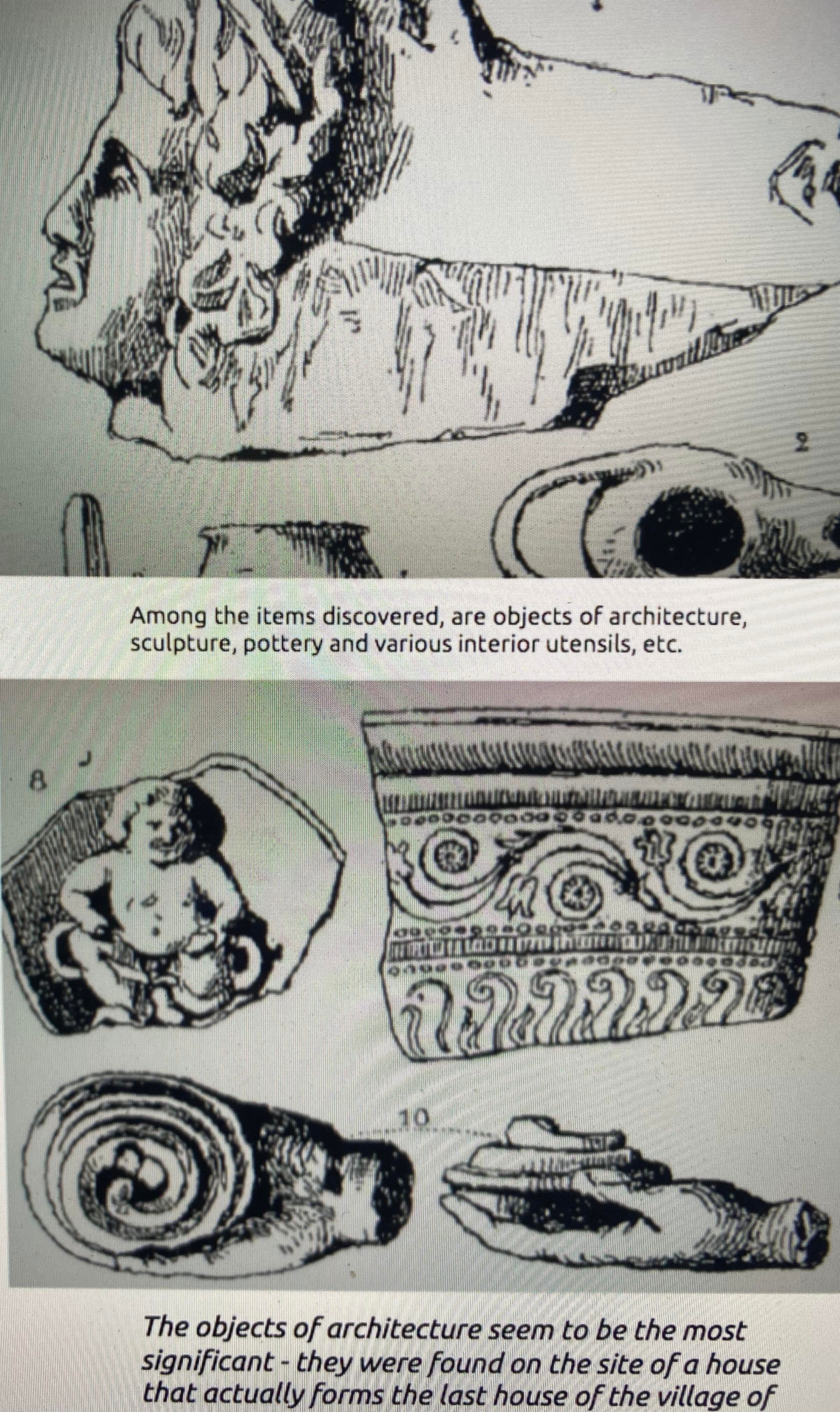

All these artefacts and pieces of statues and buildings and even the cippe dedicated to POMPEIVS QVARTVS were for Gourdon found in a Temple associated with the area of houses south of the village, in the vicinity of Maison Chalaleau [which is near the Church at Rennes-les-Bains]. The artefacts were therefore not 'scattered' but found in one particular area or actually under this house.
Boudet would appear to be protecting the artefacts instead, not gathering them from around the countryside! It is not difficult to see this must be the origin of the legendary underground Temple in Rennes-les-Bains and is probably the same Temple that Boudet refers to in his book La Vrai Langue Celtique. Boudet's book mapped an invented structure surrounding Rennes-les-Bains, his vast cromleck, with the inclusion of a secondary circle in it's centre housing a dolmen which is a tomb.
An interesting aside may illustrate Boudet better. A dolmen or portal tomb is a type of single-chamber megalithic tomb, usually consisting of two or more upright megaliths supporting a large flat horizontal capstone or "table". Most date from the Late Neolithic period (4000–3000 BCE) and were sometimes covered with earth or smaller stones to form a tumulus (burial mound). The word dolmen entered archaeology when Théophile Corret de la Tour d'Auvergne used it to describe megalithic tombs in his Origines gauloises (1796) using the spelling dolmin (the current spelling was introduced about a decade later and had become standard in French by about 1885). The Oxford English Dictionary (OED) does not mention dolmin in English and gives its first citation for dolmen from a book on Brittany in 1859, describing the word as "The French term, used by some English authors, for a cromlech ...". The name was supposedly derived from a Breton language term meaning 'stone table' but doubt has been cast on this, and the OED describes its origin as "Modern French". A book on Cornish antiquities from 1754 said that the current term in the Cornish language for a cromlech was tolmen ('hole of stone') and the OED says that "There is reason to think that this was the term inexactly reproduced by Latour d'Auvergne [sic] as dolmen, and misapplied by him and succeeding French archaeologists to the cromlech". Nonetheless it has now replaced cromlech as the usual English term in archaeology, when the more technical and descriptive alternatives are not used. The later Cornish term was quoit – an English-language word for an object with a hole through the middle preserving the original Cornish language term of tolmen – the name of another dolmen-like monument is in fact Mên-an-Tol 'stone with hole'.
A cromlech (sometimes also spelled "cromleh" or "cromlêh") is a megalithic construction made of large stone blocks. The word applies to two different megalithic forms in English, the first being an altar tomb (frequently called a "dolmen"), as William Borlase first denoted in 1769. The second meaning of the name "cromlech" in English refers to large stone circles such as those found among the Carnac stones in Brittany, France. Unlike in English, the word "cromlech" in many other languages exclusively denotes a megalithic stone circle, whereas the word "dolmen" is used to refer to the type of megalithic altar tomb sometimes indicated by the English "cromlech". Also, more recently in English, scholars such as Aubrey Burl use "cromlech" as a synonym for "megalithic stone circle". [https://en.wikipedia.org/wiki/Cromlech].
This is fascinating. Why? Because Boudet is saying his Cromleck surrounds a tomb. To further ensure the point Boudet has a whole chapter on the Pierre de Trou, the stone with a hole/hole stone. And on top of that one can use the word Dolem and Cromlech interchangeably to mean a tomb! Or perhaps the whole area is a tomb!
It would seem that the second circle structure of Boudet's Cromlech does not sit far from Maison Chalaleau and the area of its ancient Temple. One could argue that Boudet and his Cromlech surround the underground Temple at Rennes-les-Bains, which may have housed a tomb associated with the resurrection and to which the authors of the Beaucean text considered equivalent to the resting place of a female Goddess who was exhumed and then re- buried in a 'hotel courtyard'. It seems to form the basis for the descriptions of the tomb referred to in Le Serpent Rouge;
From her that I wanted to free, rose towards me the emanations of perfume which permeate the sepulchre. Once some called her: ISIS, queen of the beneficent springs, COME TO ME ALL YOU WHO SUFFER AND WHO ARE OVERWHELMED AND I WILL COMFORT YOU, otherwise: MADELEINE, with the famous vase full of healing balm. The initiates know the true name: NOTRE DAME DES CROSS.
So the buried white Queen statue is now a mysterious female associated with various Goddess's which initiates [ie the Priory] know the real identity of - Notre Dame des Cross. And there is only one lady, associated strongly with a Cross.
The mention by Gourdon of the POMPEIVS QVARTVS. P. A. M. SVO. stone is a case in point. He mentions comments by Catel [in his Memoires De L'Histoire Du Languedoc, 1633] referring to the stone's current location during the time of Catel, but Gourdon indicates that this stone had originally been part of the buildings in the vicinity of the temple he has identified with the last house in the village which we shall see below is in the area of Maison Chaluleau. This means - if correct - that some of the Temple contents associated with the area later associated with Chaluleau were well known and discovered before 1633. As we have seen, all these different and complicated strands keep returning back to the same source as it were, and this is the foundations and area of the vicinity of Maison Chalaleu. Later Louis Fédié, erudite scholar of the local Aude area observed that this Pompeius stone was originally attached to a wall in the vicinity of the "Source de la Reine". According to Gourdon, for Catel it was associated with the church of the village but for Gourdon himself it was associated with the Temple around Maison Chalaleau.
It is conceivable that the Pompeius 'cippe' did originally mark an important burial, associated with a Temple, consistent with its association by Gourdon with the last house in the village, Maison Chaluleau. The witnessed large block foundation under this house were, as we saw above, identified by archaeologists as the remains of a Roman Temple or palace. Our chronology may fail us here. How can this cippe, described by Gourdon as coming from the Maison Chalaleu [he wrote in 1874] be also familiar to Delmas, who wrote in 1709? And also Catel, who was aware of it in around 1633 when he published his great work on the Languedoc but must have known about it earlier. [He died in 1626]. It certainly suggests that the remains of the Temple were to be found in 1633.
Abbé Delmas thought the inscription on the cippe was most likely a grave inscription. He rather bizarrely and out of the blue speculated that Pompey passed through the area on an expedition to Spain and one of his close friends or high ranking officers died there. For this friend Pompey built a mausoleum and a column above the grave. The plate with the inscription would originally have been attached to this column (or to its base). All this is very odd but not as odd as what Plantard decided to then write about this Pompeius stone of Rennes-les-Bains.
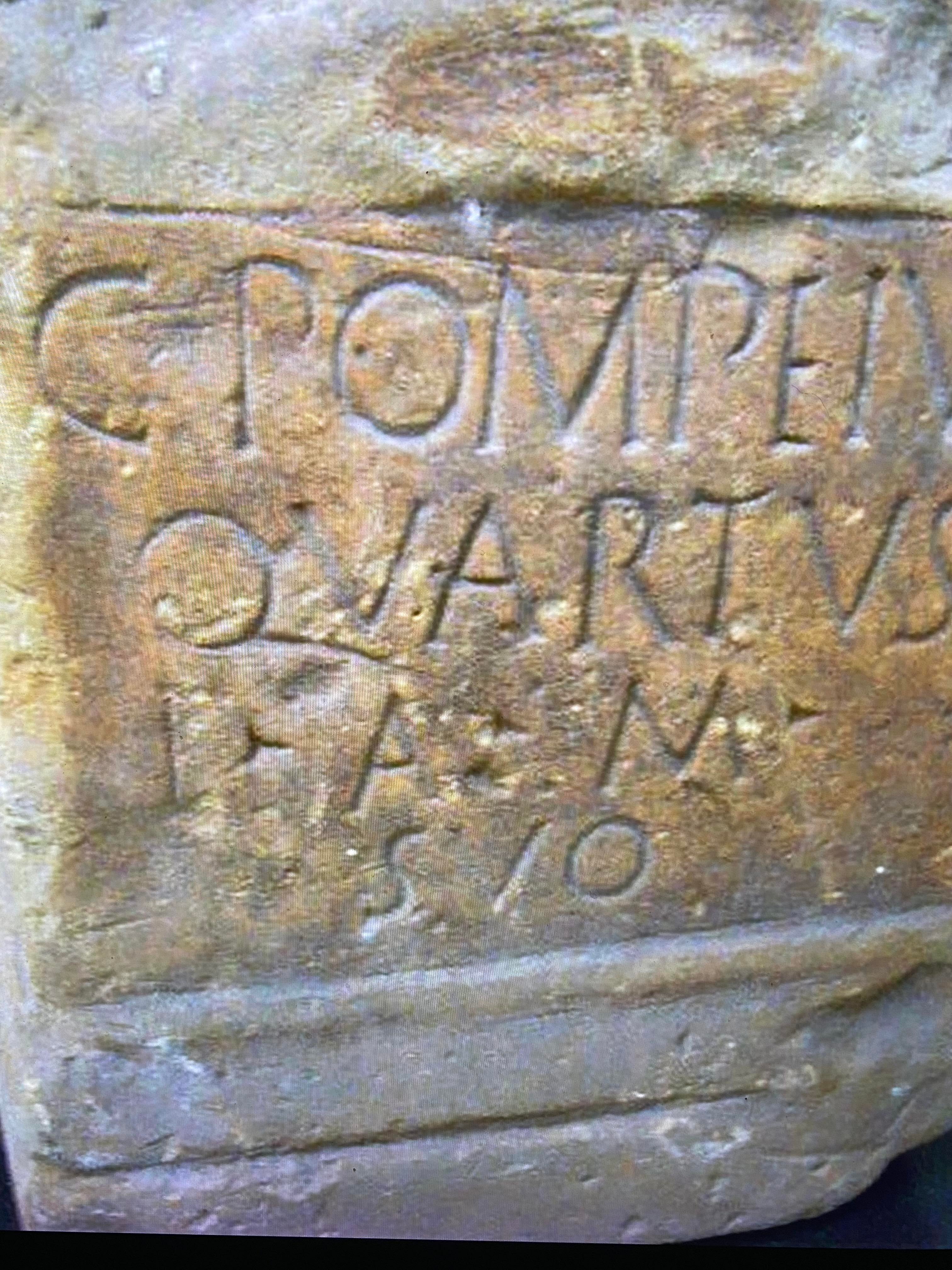
A letter from Plantard, sent to a researcher, reported;
".....I have not undertaken any researches in the Caves de la Reine (in the Rennes district), nor in the Souterrains du Roi ("underground chambers of the King"), so there have not been any researches or investigations on my own property... This property ...has the following boundaries: to the South – chemin de Farres; to the North – Roc Pointu; to the East – the main road to Rennes-les-Bains; to the West – the mountain top. On my property are two mines: a copper mine and a gold mine... , the gold mine dates from the Roman era, from about 70BC. This piece of land is called Roc Nègre. You refer to the tombstone of Coumesourde. I'm sorry to have to disappoint you, but it simply never existed. On the other hand there IS a text dated 1880 or 1890 written by the engineer Ernest Cros based on the Zero Meridian of Paris and the English equivalent in Greenwich (the latter being situated at 9 metres 20.9 seconds west of the Paris Meridian). The triangulation for this study was based at Pontils, between Peyrolles/Serres, at the location of a tomb. The "secret location" to which you refer is the Roman tomb (50-48 BC) called the Tomb of Gnaius Pompey, which is located in Fangalots at a distance of 1 kilometre 500 metres from my property. It is located between two belfries – those of Rennes-les-Bains and Rennes-le-Château, at 500 metres’ distance from the belfry of Rennes-les-Bains. With all good wishes, and please do keep me informed of your researches." [my emphasis].
So for Plantard this Roman Tomb called the Tomb of Grand Roman was near his property and he thought, like Delmas, that it was the tomb of Pompey. I find it interesting that he talks of a gold mine from 70BC - why so precise? [Here you can see what happed in 70BC].
In a diagram by Cherisey we find the following;
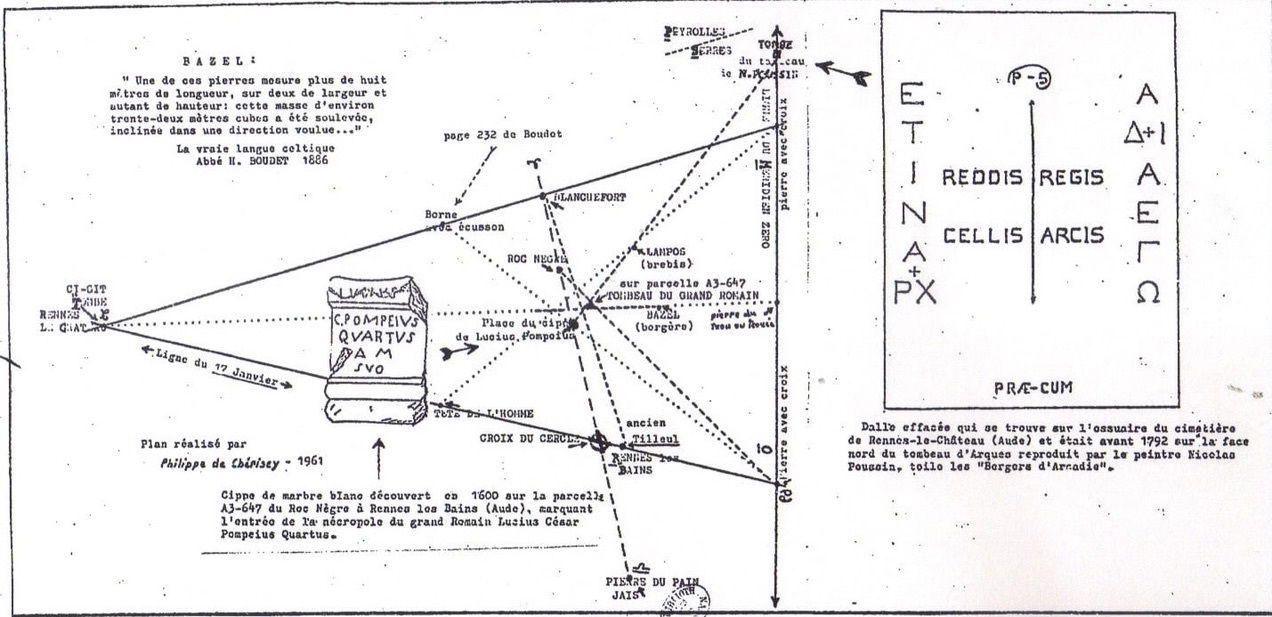
You can see here that Cherisey is describing a cippe found at the foot of Roc Negre marking the entrance to the necropolis of the grand Romain Lucius Cesar Pompous Quartus, and then towards Cardou is the actual tomb of the Grand Romain.
Plantard then talks about another tomb at Pontils! And then another 'secret location' of a Roman Tomb [he dates it to 50-48BC, probably because this was the sate the real and famous Pompey died?] located at Fanglaots [1.5km away from my property], he locates this between the belfries of Rennes-les-Chateau and Rennes-les-Bains, and 500m away from the belfry of the church at Rennes-les-Bains. This must be what the above diagram is showing.
To my astonishment though, while perusing the Secret Dossiers, i came across a statement in the text as follows;
"The decoration (to) the setting to the tomb referred to [i.e. the 14th station of the Cross at Rennes-le-Chateau] is ...of the necropolis of Fangalots at Rennes-les-Bains'
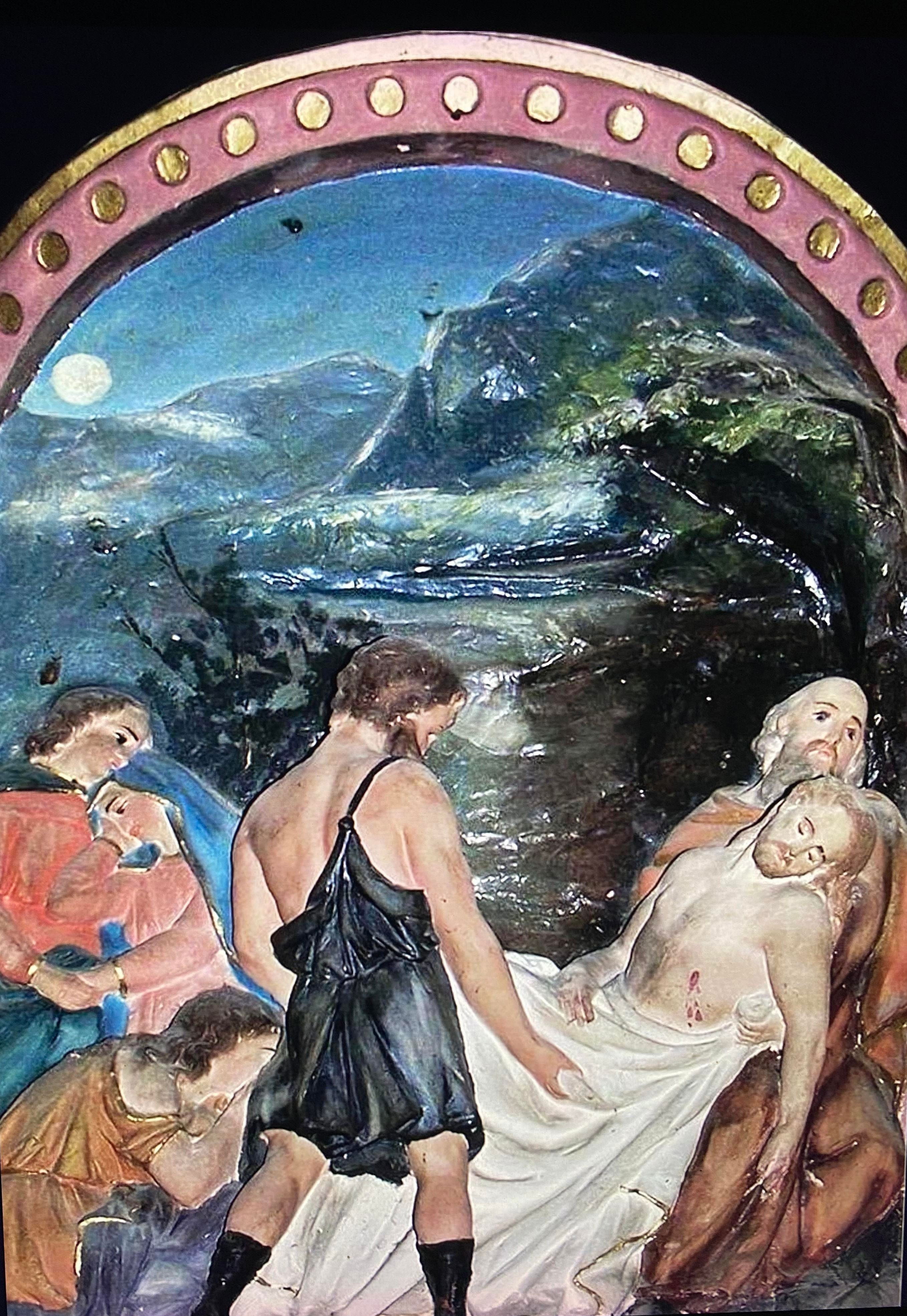
This strange Secret Dossiers quote was placed next to a picture of Sauniere's 14th station of the Cross to remove all doubt [the 14th station represents the taking of the body of the historical Jesus, to his tomb.] Was Plantard intimating that the tomb of Jesus as depicted in Saunieres's 14th Station of the Cross represents a necropolis at Fangalots!
Delmas' tomb of the Grand Roman then, has via Plantard, morphed into a tomb at Fangalots of Jesus Christ! Fangalots itself is just above the house of Chalaleau - in the landscape - a large forest and canopy overhanging Rennes-les-Bains. It affords panoramic views of the village from its elevated plateau. Couple this with Boudet's mysterious burial at the heart of his imaginary Cromleck which he associates with a resurrection, with a small 'r', we have some very strange assertions being made for this village! One can wonder if the central tomb of importance for Boudet, if it is not the Resurrection with a capital 'R' , is the resurrection with a little 'r' signifying perhaps that of Lazarus? This biblical character has legends of being buried in the locality.
I have above drawn attention to the text regarding Gourdon's assertion that 'architecture [&] sculpture' had been found at the site of a house that forms the last house of the village of Bains, to the South; this is almost word for word those used by Boudet when describing archaeology he had found to his visitor, Henri Rouzaud. Dr. GOURDON gives a drawing of a sculptured ‘head’ representing a female as a piece of architecture also found at Rennes. The sketch is reproduced by Courrent unfortunately not to scale, but the author says;
"It is a carved stone ornament of light colour and of an elegant design”.
Gourdon calls it an 'antefix' and was found, once again, in one of the houses to the south of the village. The date of finding was probably around the building of the original house in the village [1860's?] - long after the time of Delmas, but definitely during the time of Gourdon, which is why Gourdon refers to it but Delmas [1709] does not!
Again this caught the attention of Doctor Courrent, who wrote in his monograph about Rennes-les Bains;
"One can see, set into the wall of the presbytery, at the side of the garden, an elegant ornament represented by figure - 1 sheet 1 of our monograph - an image borrowed from the works of Doctor Gourdon'.
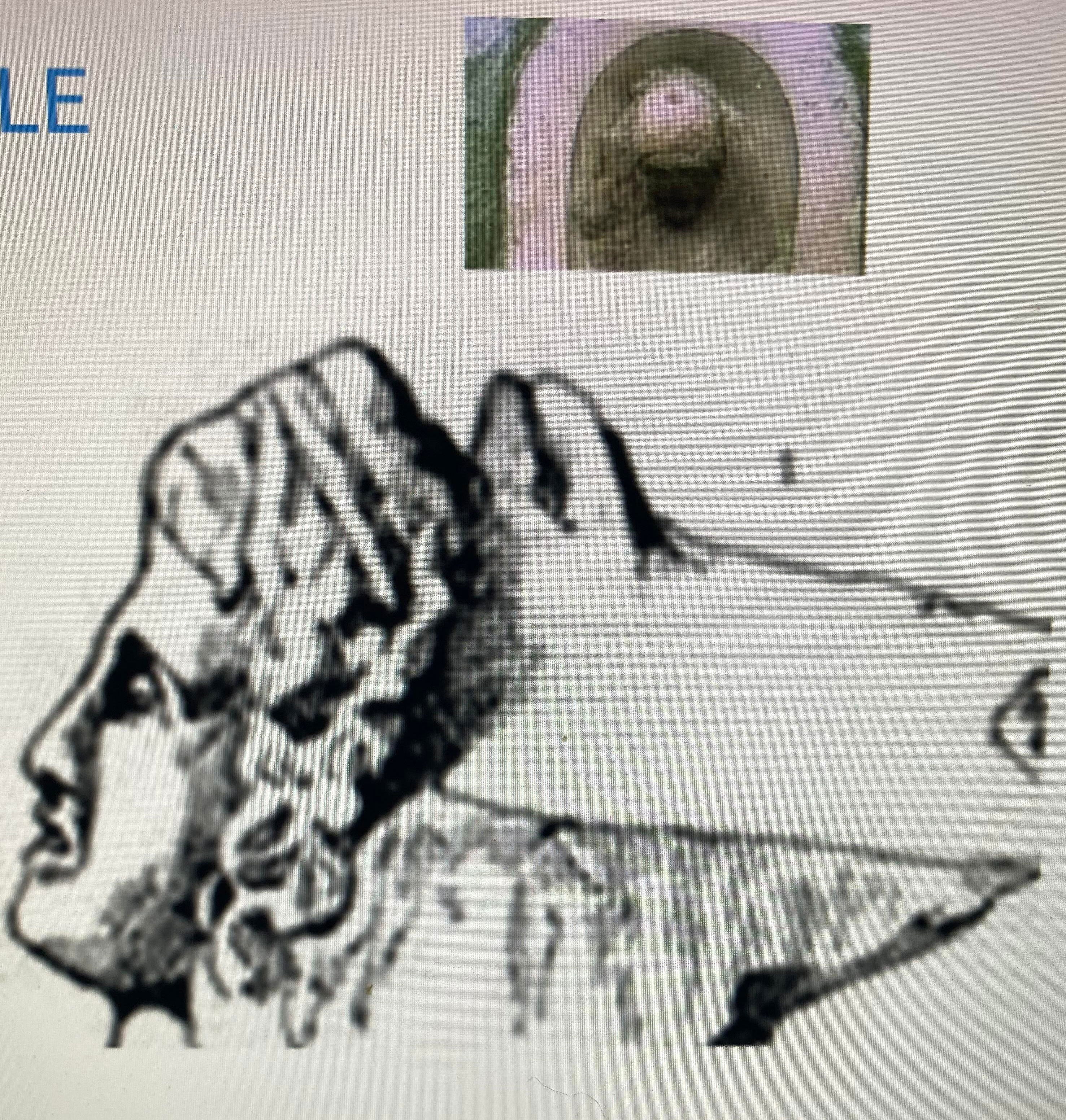
Above - the sketched head referred to by Gordon, and inset the head in the presbytery wall of the church at Rennes-les-Bains
Local archaeologists in 1969 discussed this 'head' of Gourdon and felt it was NOT the same head found in the presbytery wall to which Courrent attested. They speculated that the ‘head’ from the Temple represented a Goddess icon - suggesting that the village of Rennes possessed its own goddess. They wrote:
"If she seems frustrated at first because of wear, it can be seen in the comprehensive review that the artist was clearly influenced by Roman provincial sculpture. The hair, split into two bands, but without a marked central line, is frequently encountered in our region from the early Roman Empire and the first century. Only the front part is shown and it is difficult to predict the presence or absence of the face, albeit in somewhat heavy character that is often found in indigenous works, seems treated conventionally .... What date could be assigned to this work? Do not forget that we have here a work that is indigenous and therefore does not interpret the cumbersome forms as a late sign, need only compare with certain Sculptures in the Museum of Narbonne, same style, carved in similar sandstone, and of the same epoch. If one refers to the test, that of the hair, we are led to consider it quite old: the statue of the captive trophy of St Bertrand de Comminges, as given before the start of our era is similarly capped. Geographically close, the statue of the deceased heroine Bourièges has a similar provision of the severed head of hair. It seems that we can locate it near the beginning of our era.... This coincides with the most flourishing period of the spa, which had great importance in the first century before our era. This prosperity, to its maximum, in the Augustan period, must extend to the early first century, if we believe the monetary findings. It seems that the Romanisation of a much older water cult should be considered the most likely".
Gourdon did not link his head to the presbytery but with the site of a house that again formed the last house of the village of Bains, to the South! We are surely building an image here of a large Roman Temple complex, buried now, probably after a fire, but to which the foundations have been seen, covering an expanse of space encompassing the south of the village, that is Maison Chaluleau and probably the modern town square [under which is some sort of burial crypt/vault is to be found] and to the church [hinted at by Cherisey in Circuit]. All the artefacts and finds associated with the Fleury's and their cabinets of 'curiosity' are the artefacts all found from this Temple complex associated with this area. An important part of the architecture involves a female head - probably of a local Goddess or Romanised Goddess, from the early Roman Empire and the first century.
Perhaps Gourdon was right, the famous head of Rennes was originally found in the vicinity of the valley of Le Cercle, or the last house of Bains and represented a local Goddess and divinity of the spa town, or water cult, Romanised when the Romans took over the site and that it was indeed an antefix found on a public Temple building in the area. We already have eyewitness accounts to Temple remains in the foundations of Maison CHALULEAÛ. But ultimately, even if there is Roman Temple foundations beneath this house, it is simply just Roman archaeology, interesting though it is, why all the mystification?
The date of finding of these artefacts originally, including Boudet's Venus statue appears to have been before 1874 and Gourdon was aware of them. As we saw above the significant point Gourdon makes is that the objects of architecture - found on the site of this house that forms the last house of the village of Bains, to the South. This correlates with information given by Boudet to Henri Rouzaud. During the year Rouzaud visited [1910], he had been invited by Armand Bories, [former notary of Narbonne and member of the same Archaeological Commission of Narbonne since July 1885], to go to Rennes-les-Bains and meet Henri Boudet. Armand Bories is not completely unknown to us - he bought, along with MM. Coll and Satgé, during an auction in June 1889 the thermal baths and certain lands which at that time belonged to the Fleury family. It was this Fleury family who had all these archaeological remains originally.
Rouzaud wrote in his notebook about his visit the following:
"September 2, arrive in Rennes at 7 am, visit in the morning to the Bain Fort where Mr. Bories showed me the arms of 2 large marble statues found in the past where it is believed that there was a temple from Roman times (blacksmith's house) at the end of the crossing which leads to Rennes-le-Château and almost on the current road, which goes from the Bains to Sougraigne. The parish priest of Rennes, who has been there for many years, and called Mr. ?B?o?u?s?q?u?e?t? Boudet, told us that he saw almost all the houses built which go from that of the blacksmith upstream, along the road and he said he saw the foundations and the large base stones of this Temple. Although in itself, one of the hands of this statue holds a very regularly coiled snake flat: the head of the snake, which alone was broken and is missing. This arm must have belonged to some statue of Aesculapius or Hygieia. The other arm under the hand is broken but has fingers and pieces of fingers, seems larger and must have belonged to a different statue. She held between the first 3 fingers a marble hen's egg, of natural size which has been preserved and which bears the circumference of the contact of each of the fingers. Of what deity was this egg the attribute? [September 2, 1910: visit of Henri Rouzaud to Rennes-les-Bains].
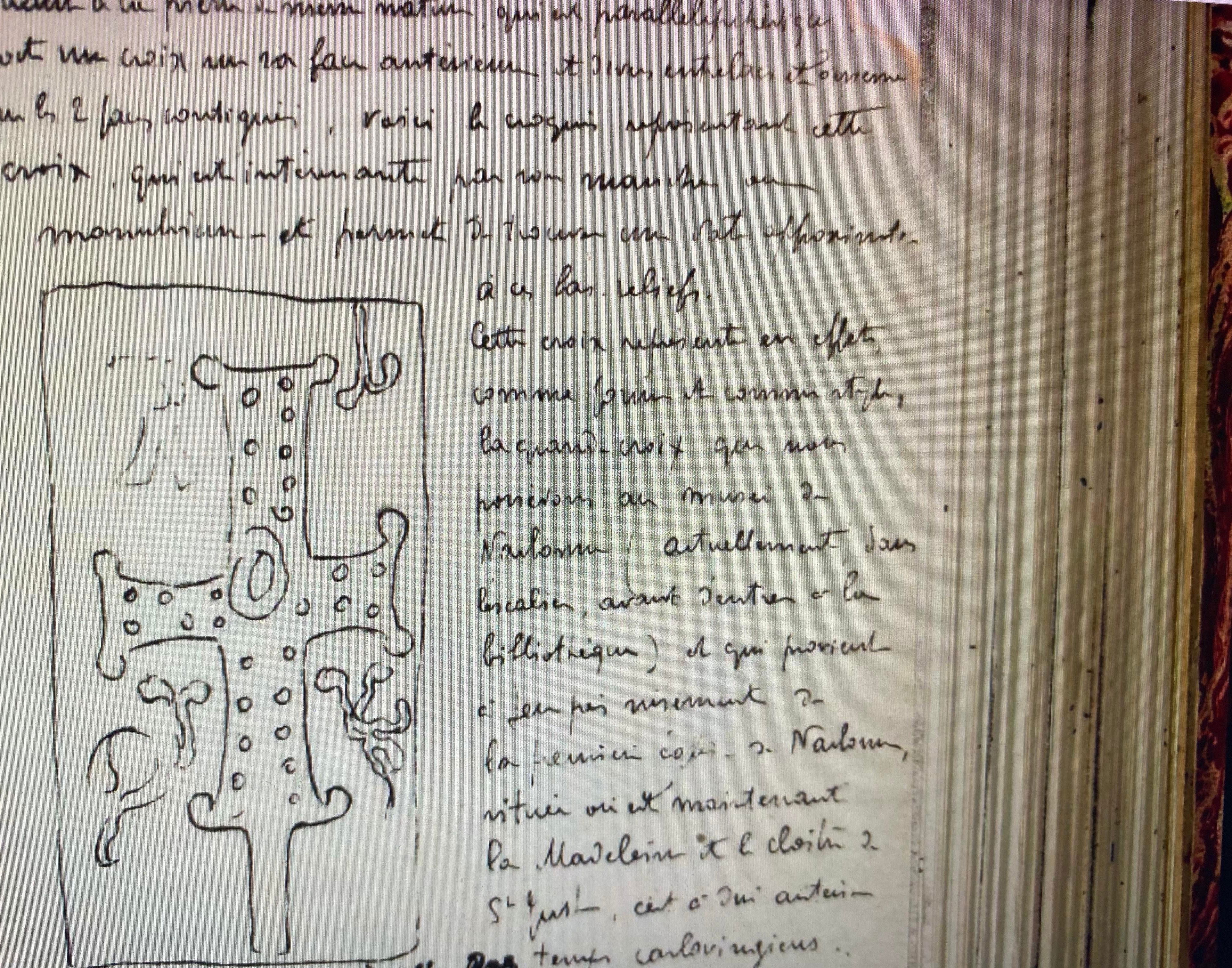
Above - a page from the diaries of Rouzaud - who wrote about his visits to the Two Rennes.
Rouzaud seems to adhere to Boudet's interpretations and Gourdons' too. Boudet does not hesitate to reveal to the former deputy that he saw the foundations and the base stones of an ancient Roman temple and even indicates its location; "at the house of the blacksmith at the exit of the crossing which leads to Rennes-le-Chateau on the current road, which goes from Bains to Sougraigne”. i.e Boudet is indicating the ancient carrefour of the village of Les Bains [see below - a rare word for crossroads or a public square, especially one at the intersection of several roads. The word origin is from Old French quarrefour, ultimately from Latin quadrifurcus - having four forks] - the actual cross-road of the Cardo Maximus and the Decumanus Maximus right by Maison Chaluleau!
A French researcher followed this up and wrote on a French forum;
'In order to locate the House of the blacksmith, I looked with precision at the census, the house of Cros is located at the 63rd place/family on 67 to Rennes-les-Bains, which lay at the end of the village at the time. By paying attention to the close vicinity of the Cros family, we can note the presence of the boarding school for girls run by nuns, who are at the 61st place, two houses before that of the blacksmith. The location of the boarding school is identifiable by its religious niche on the façade'.
The researcher went on to say that the blacksmith's house is easy to establish:
"The great Arch of the opening matches the type of activity of a farrier. It should be noted this building leads on the way to Fangalots leading to RlC, which fits the description of Rouzaud. This being established, [we] may therefore consider that from the Rouzaud notes: "Boudet said we have seen almost all the houses upstream that range from this blacksmith house, along the built road and he said he saw the foundations and the large base stones of this Temple & that the temple is located in this area".
So it seems this area of the Maison Chaluleau and its environs [i.e. the houses next to it] are vitally important. And it seems that the whole Priory literature is to do with this site.
But again, why all the mystification?
This same type of mystification also seems to me to be at the root of the Roman Temple that Boudet describes and refers to in his book, La Vrai Langue Celtique. Boudet describes two cromlecks in his book, a smaller one within a larger one. Boudet's map illustrating the Cromlecks conceal surprises ... the larger cromleck begins with the confluence of the Rialsesse with the Sals, and then goes on to the castle of Blanchefort, the Cugulhou du couchant, the Roeselare, theTrinque Bouteille stream, the Dead Man, the Pic de la Roque, Goundhill, the Garosse, Ferrière, Cugulhou du Levant, le Fagole, the crosses of Montferrand, Bazel and Cardou. The smaller cromlech, more limited and included in the larger one, begins at the hamlet of Le Cercle. It continues with Trinque Bouteille, Serbaïrou and Roukats. But Boudet's perfect circles which are supposed to define cromlechs are not circles. Worse, the centres of the two cromlechs that he considers fundamental are not geometric centres.
The environs of Chaluleau can be said to be in the vicinity of the smaller cromleck. Chalaleau itself includes parts of two possible other houses and several buildings in close proximity to each other which could have been over-lapping in earlier years.
Cue an interesting comment by a researcher using the non de plume Michel Montbard.
He wrote on the old Arcadia forum the following:
"...a few years back, there was a very interesting debate on a french forum. Someone had some bold theories, claiming information from a local villager. According to local legend there is a house in Rennes-les-Bains which for several generations belonged to a family with links to Abbe Boudet; the Cathary Family. … in this house there is a well called Puit du Cercle - it can be filled with water and emptied when needed. The Well gives access to a circular underground structure. This ancient structure only has half of it remaining, because the other half has collapsed as a result of flooding or landslides".
If this local legend is true then the Chaluleau house we seek is the Maison Chaluleau - Cathary [from 1900], prior to that known as or perhaps connected to the Maison Aveilla Etienne. We know that the original house was built in around 1860 so maybe some of these archaeological discoveries were made in relation to these building works? Gourdon published his book about these finds in 1874 - just 14 years after the house was built but again rebuilding occurred at the time of Boudet and perhaps even later. If the legend cited above is based on fact & the Puit du Cercle does give access to an underground structure, it most certainly will be the remains of the Roman Temple identified by witnesses and where most of the archaeological finds we have been discussing have been made.
Maison Chaluleau was for sale many years ago and while visiting with friend Rene Barnett - I was invited by some locals to look around the house. We visited all the floors, even looking out of windows of the house on to the main Square of Rennes. We went out to the back and down some stairs and we took pictures and saw the structure [with a lid] that was identified as the Well. Rene was even given some plans to the house.
Two Rennes researchers have published a book identifying this well. The diagram below is one of it's illustrations of how the village may have looked in Roman times and the well is signified by the small black circle dot.

The ancient well sits in the grounds of Chaluleau, towards the back not far from its presumed by its 'courtyard'.
So the Priory have signified the existence of an underground Temple via transpostion. In historical literature this Temple may be the one associated mostly under the houses and their foundations at the old southern end of the village [before the building of modern structures], which includes under the main square of Rennes-les-Bains and probably towards the church and its cemetery.
But why do the Priory want to signify this area in this way?
Further they have transposed ideas of a Queen [Reine] and a fragrant tomb. This Queen is associated with a mysterious perfume, where the emanations and scent of the perfume permeate a sepulchre! The Queen of a lost realm associated with Isis or Venus?
Kings, queens, tombs, perfume? A fragrant and perfumed tomb? So to whose tomb then, does this belong?
There is a fragrant tomb associated with a 'special' female and this will be the subject of the next article in this series. And perhaps using transposition and other literary tricks already identified above we can have a guess at this important character? However is she the body buried in the tomb, or is the important burial the person she carried fragrant spices to anoint? How is it related to a crypt to be found under the Place des Deux Rennes [where i have sat many times and had lunch!] and how does it fit in with the rest of Priory mythology?
Below: the ancient village of Rennes superimposed on to the modern village.
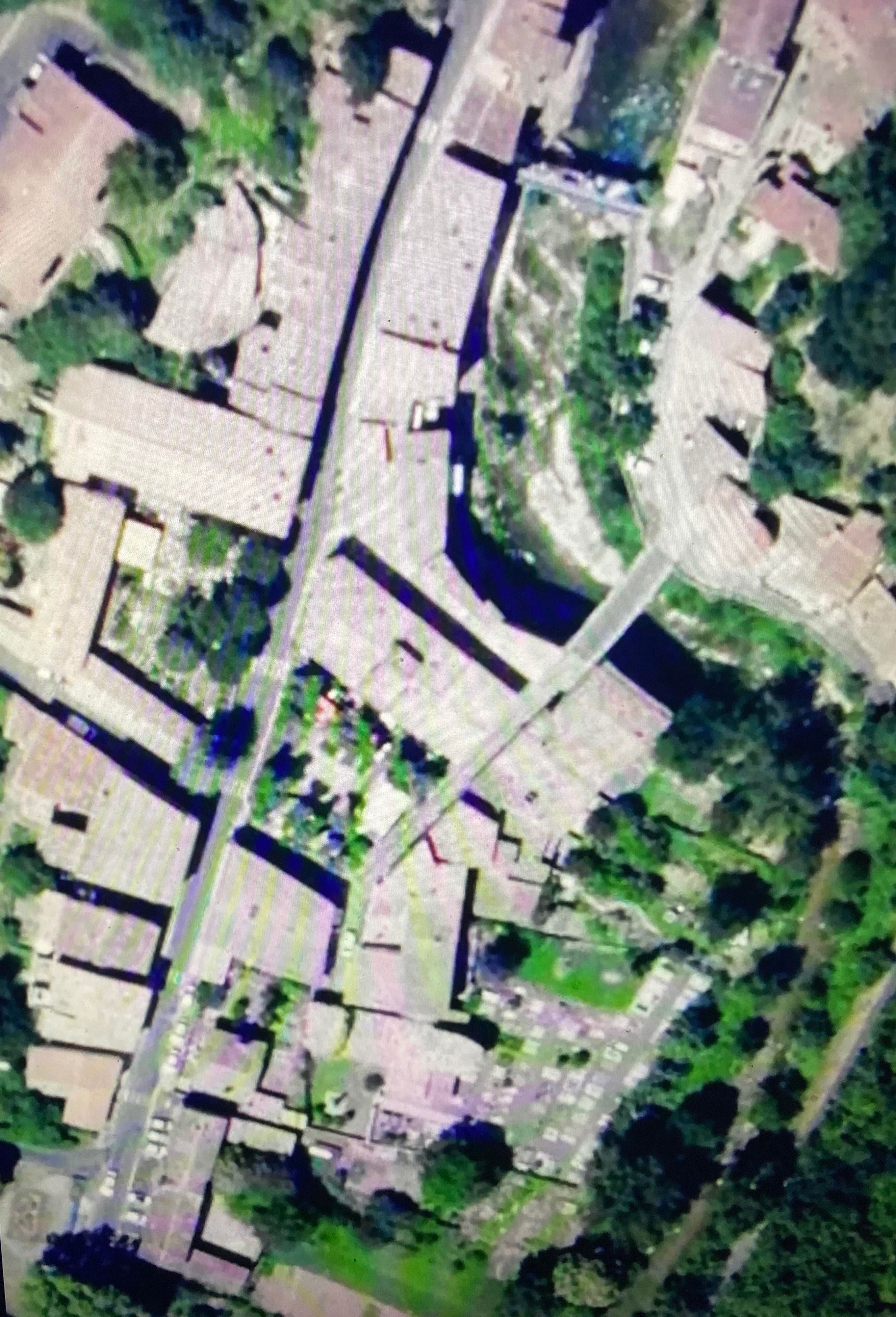
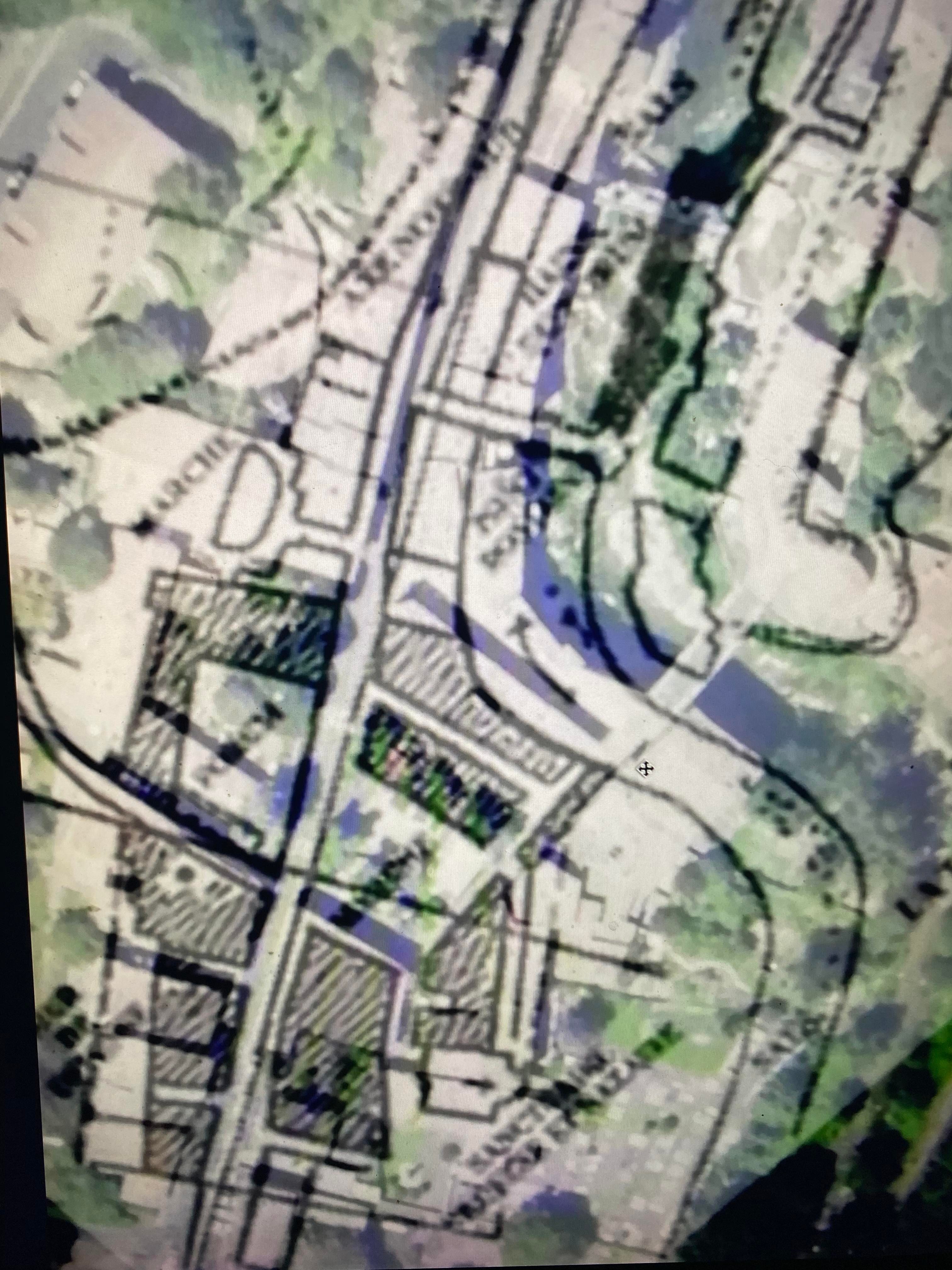
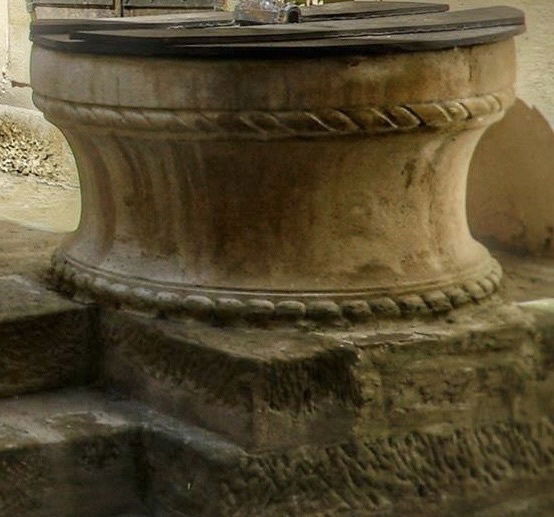
Above - a photo of the famous well referred to by Michel MONTBARD
Below: more concrete visualisations of some suggestions in this article:
